How to Make a Printed Circuit Board (PCB) Using the UV Light LED Method.
by JoeyJunior in Workshop > Science
305127 Views, 223 Favorites, 0 Comments
How to Make a Printed Circuit Board (PCB) Using the UV Light LED Method.
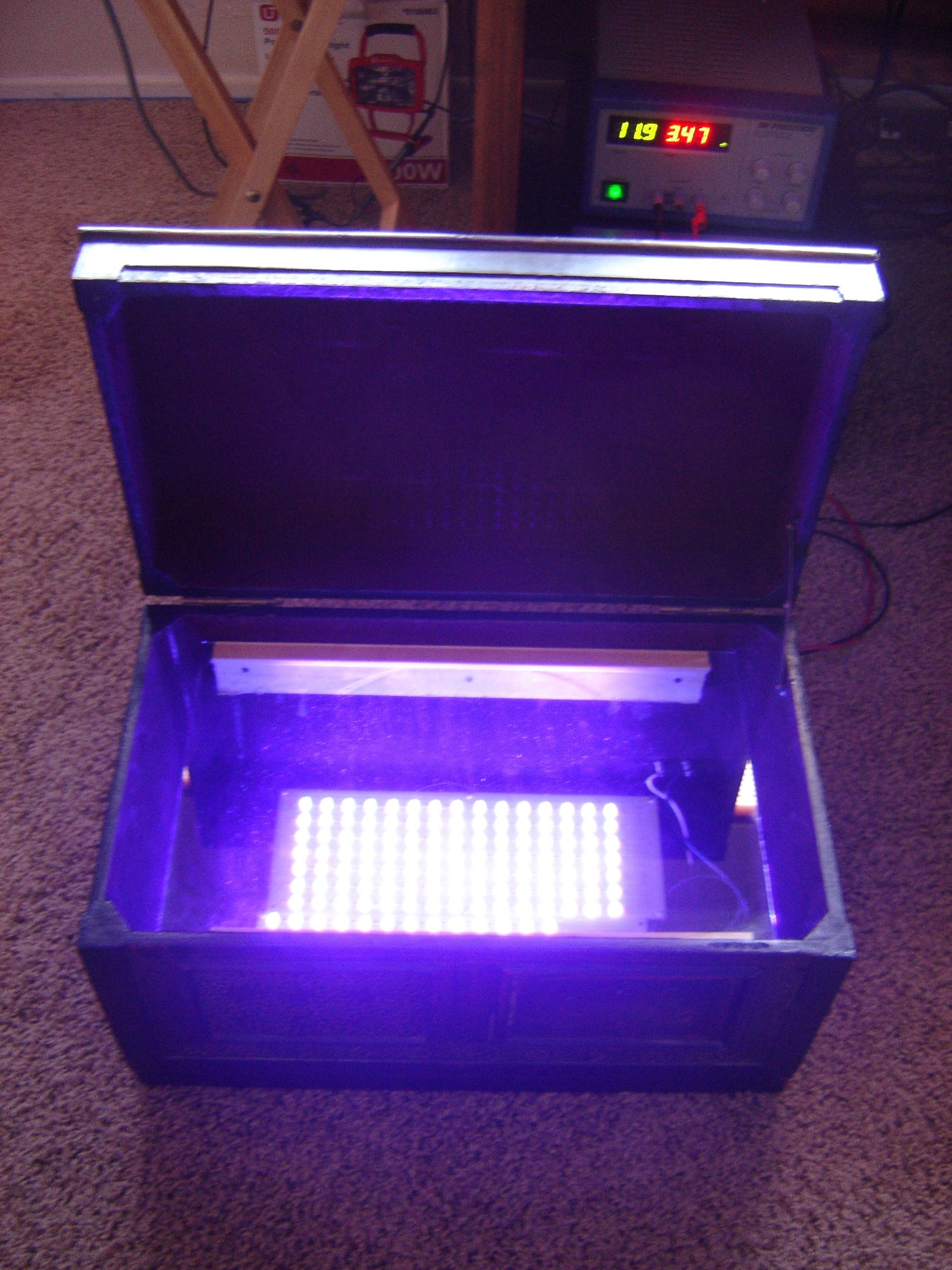
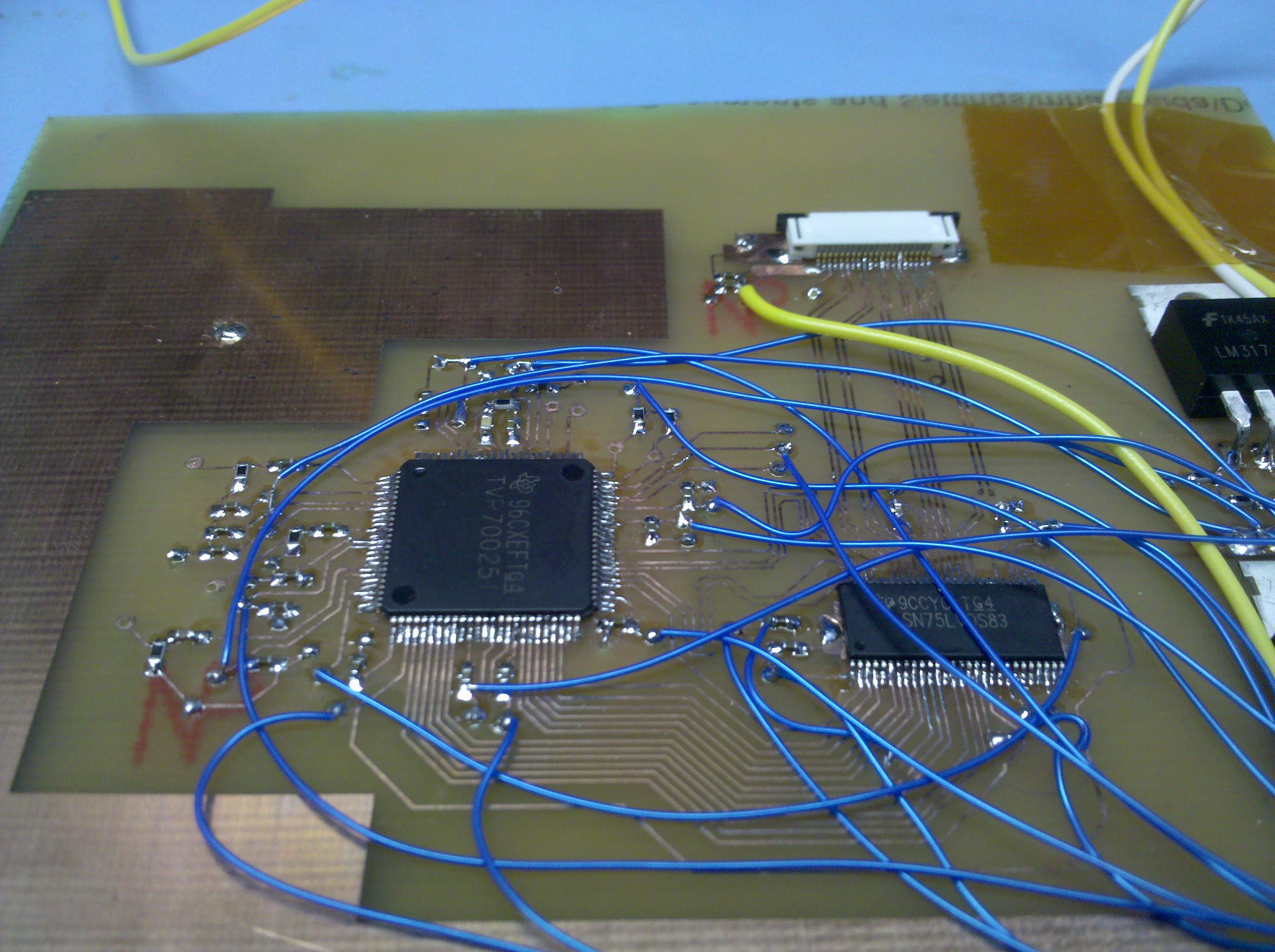
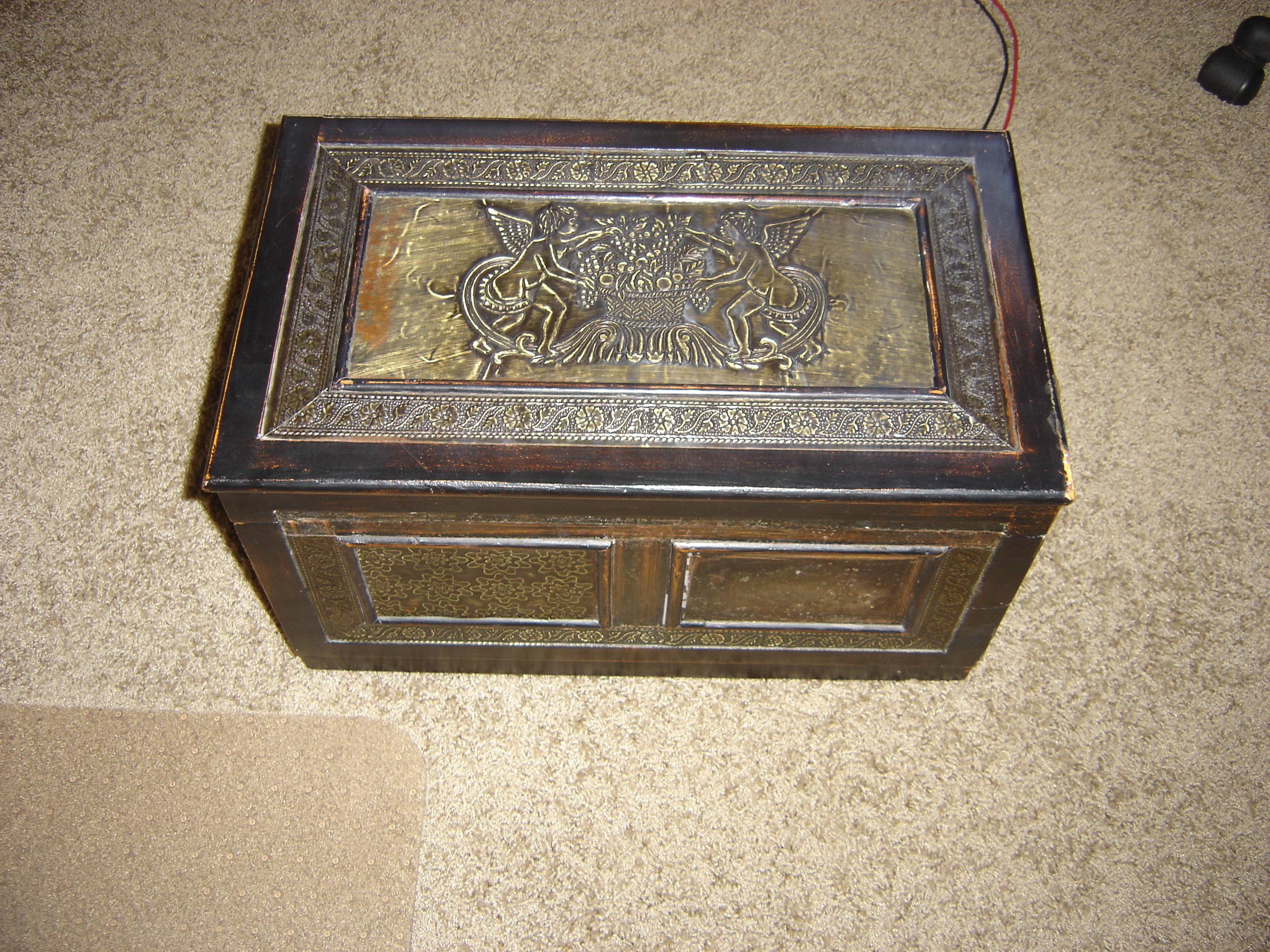
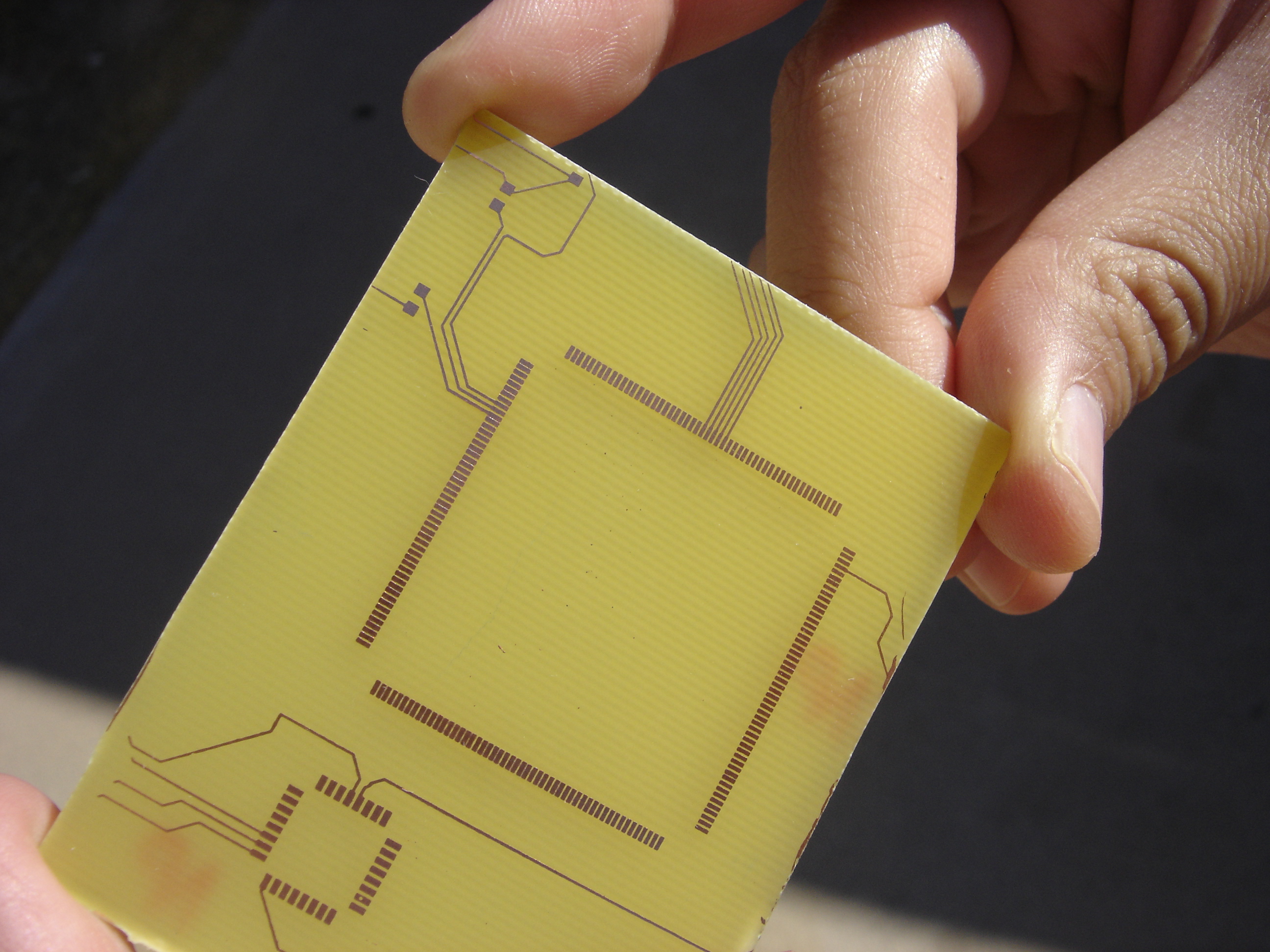
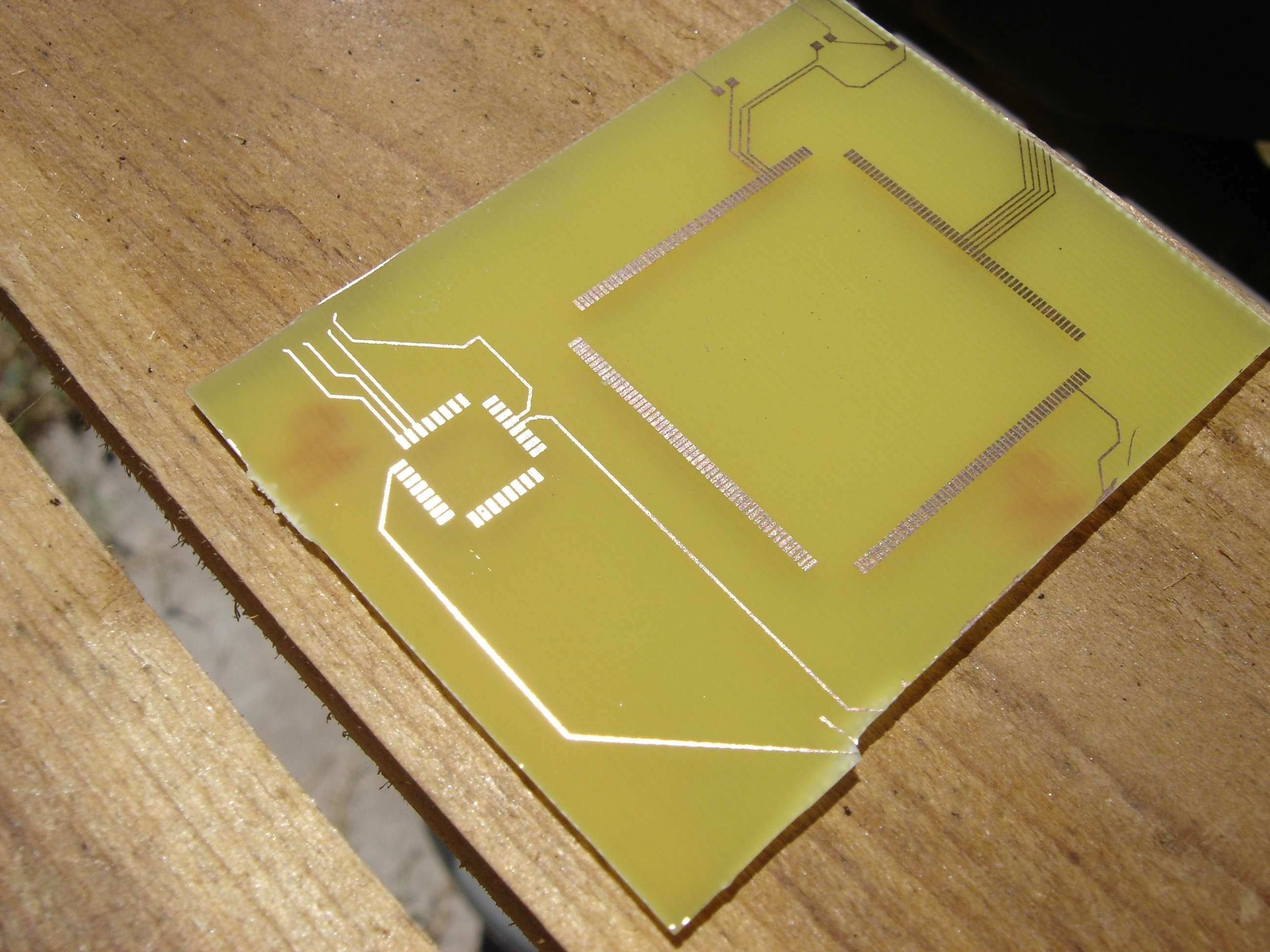
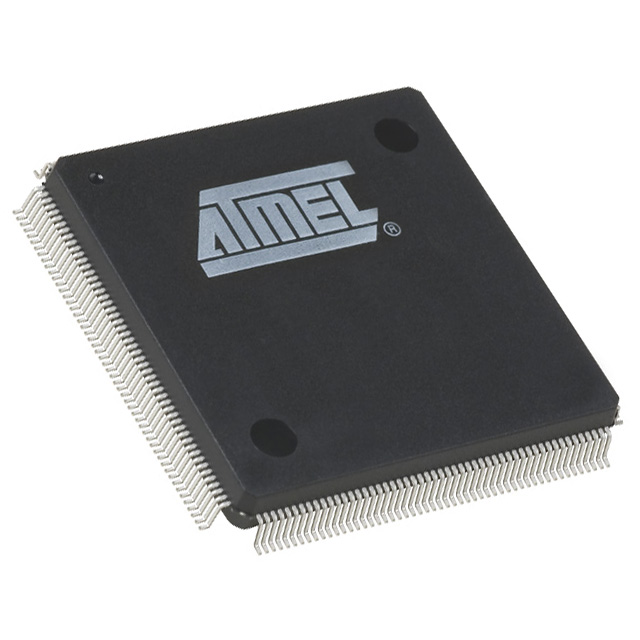
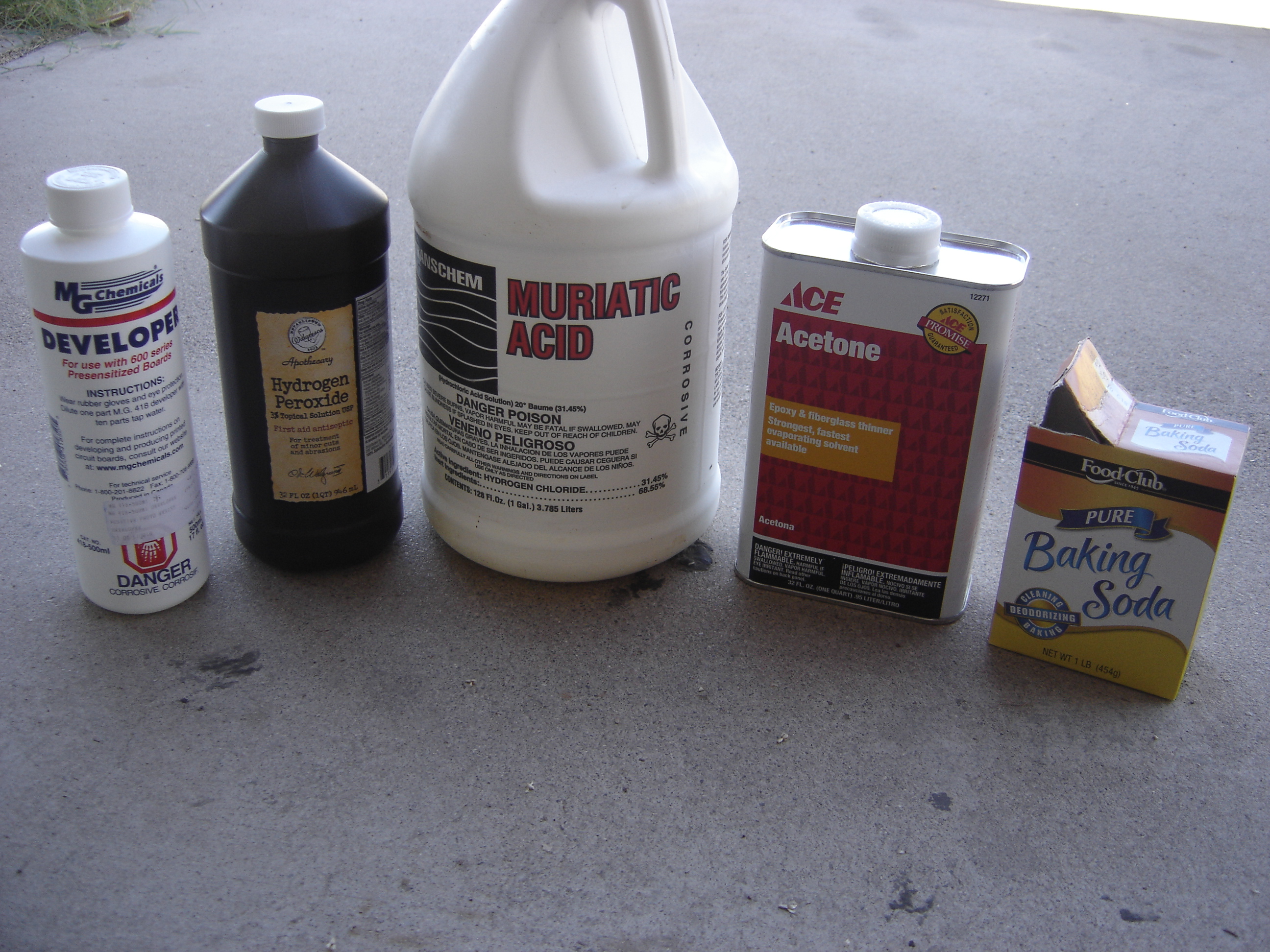
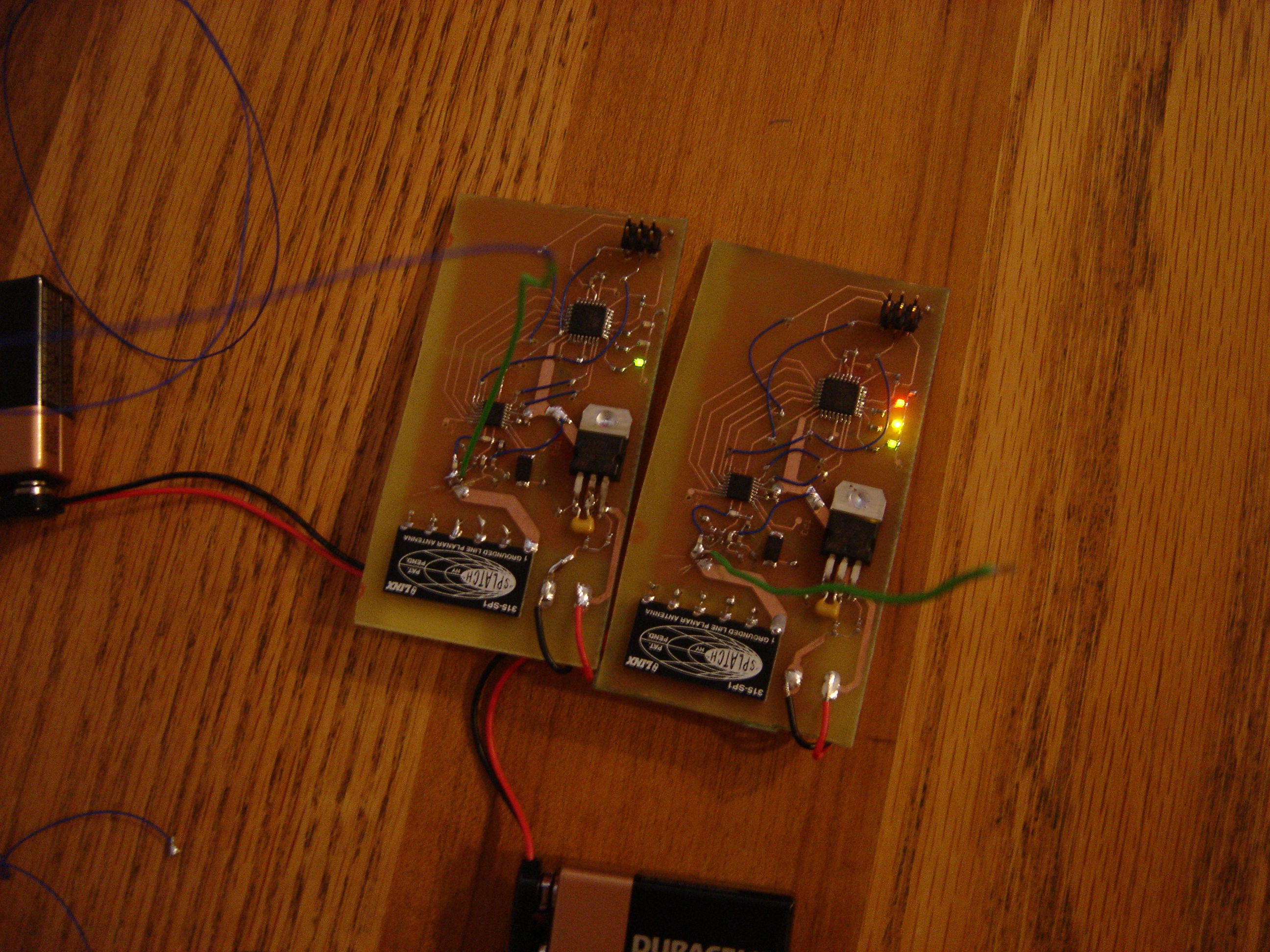
This instructable shows how to create well done PCB's using Ultraviolet light. It took us about 40 boards before we perfected our PCB, so we will share what worked and what didn't work. All the supplies can be bought from Fry's Electronics, Ace Hardware, Goodwill, Radio Shack, and Ebay . Our PCB tested the Atmel 208 pin PQFP Integrated Circuit (it may not look like it from the poor image quality but there were no shorts between all 208 pins! ).
The materials needed are as follows.
PCB:
-Transparencies (MG chemicals brand http://www.mgchemicals.com/products/416t.html )
-UV Presensitized Copper Clad Boards (MG chemicals brand http://www.mgchemicals.com/products/600.html )
-Laser printer (Brother HL-2070N)
-200 UV LEDs (Bought from Ebay - Asia Engineer, seller giorgio11185. 5mm size, 3.4~3.8 forward voltage, forward current 20 mA, wavelength (nm) 395-400-405, view angle about 25 degrees.)
-200 470 ohm resistors (included with Asia Engineer LEDs bought on ebay. I used 12V for each LED).
-4 Breadboards for LEDs (http://www.radioshack.com/product/index.jsp?productId=2102843 )
-PCB Standoffs (http://www.radioshack.com/product/index.jsp?productId=2102848 )
-Chest/box to house LEDs (Bought at Goodwill. 20 inch length x 12 inch width x 11 inch height)
-Picture frame transparent plastic (Bought at Goodwill)
Chemicals:
-Muriatic Acid (http://www.acehardwaresuperstore.com/transchem-muratic-acid-for-use-in-etching-concrete-p-5243.html )
-Hydrogen Peroxide (http://www.walgreens.com/store/product.jsp?CATID=302248&navAction=jump&navCount=0&nug=VPD&skuid=sku1375525&id=prod1375535 )
-Photoresist Developer (MG chemicals brand http://www.mgchemicals.com/products/418.html )
-Baking Soda (local grocery store. Use if any acid is spilled on your skin)
-Acetone (Ace Hardware)
Tools:
-Soldering Iron (any soldering iron will do, I used http://www.amazon.com/Weller-WESD51-Digital-Soldering-Station/dp/B000ARU9PO/ref=sr_1_1?ie=UTF8&s=hi&qid=1246827601&sr=1-1 )
-Solder (We originally bought Lead free solder. This type of solder did not work. Instead we used Sn63/Pb37, 2.2% Flux, 23 gauge MG Chemical brand)
-Screwdriver
-26 and 16 gauge wire
-Wire stripper
-Gloves (bought at Ace Hardware)
-Goggles (bought at Ace Hardware)
-Power Supply (wall wart or benchtop power supply will do. Make sure your power supply can handle the current the LEDs consume. As you can see from my photo, my voltage was 11.9V and 3.47 Amps were consumed).
-Q-Tips (local grocery store)
-Buckets for chemicals (Ace Hardware)
-Timer
The materials needed are as follows.
PCB:
-Transparencies (MG chemicals brand http://www.mgchemicals.com/products/416t.html )
-UV Presensitized Copper Clad Boards (MG chemicals brand http://www.mgchemicals.com/products/600.html )
-Laser printer (Brother HL-2070N)
-200 UV LEDs (Bought from Ebay - Asia Engineer, seller giorgio11185. 5mm size, 3.4~3.8 forward voltage, forward current 20 mA, wavelength (nm) 395-400-405, view angle about 25 degrees.)
-200 470 ohm resistors (included with Asia Engineer LEDs bought on ebay. I used 12V for each LED).
-4 Breadboards for LEDs (http://www.radioshack.com/product/index.jsp?productId=2102843 )
-PCB Standoffs (http://www.radioshack.com/product/index.jsp?productId=2102848 )
-Chest/box to house LEDs (Bought at Goodwill. 20 inch length x 12 inch width x 11 inch height)
-Picture frame transparent plastic (Bought at Goodwill)
Chemicals:
-Muriatic Acid (http://www.acehardwaresuperstore.com/transchem-muratic-acid-for-use-in-etching-concrete-p-5243.html )
-Hydrogen Peroxide (http://www.walgreens.com/store/product.jsp?CATID=302248&navAction=jump&navCount=0&nug=VPD&skuid=sku1375525&id=prod1375535 )
-Photoresist Developer (MG chemicals brand http://www.mgchemicals.com/products/418.html )
-Baking Soda (local grocery store. Use if any acid is spilled on your skin)
-Acetone (Ace Hardware)
Tools:
-Soldering Iron (any soldering iron will do, I used http://www.amazon.com/Weller-WESD51-Digital-Soldering-Station/dp/B000ARU9PO/ref=sr_1_1?ie=UTF8&s=hi&qid=1246827601&sr=1-1 )
-Solder (We originally bought Lead free solder. This type of solder did not work. Instead we used Sn63/Pb37, 2.2% Flux, 23 gauge MG Chemical brand)
-Screwdriver
-26 and 16 gauge wire
-Wire stripper
-Gloves (bought at Ace Hardware)
-Goggles (bought at Ace Hardware)
-Power Supply (wall wart or benchtop power supply will do. Make sure your power supply can handle the current the LEDs consume. As you can see from my photo, my voltage was 11.9V and 3.47 Amps were consumed).
-Q-Tips (local grocery store)
-Buckets for chemicals (Ace Hardware)
-Timer
Build Your UV LED Light Box.
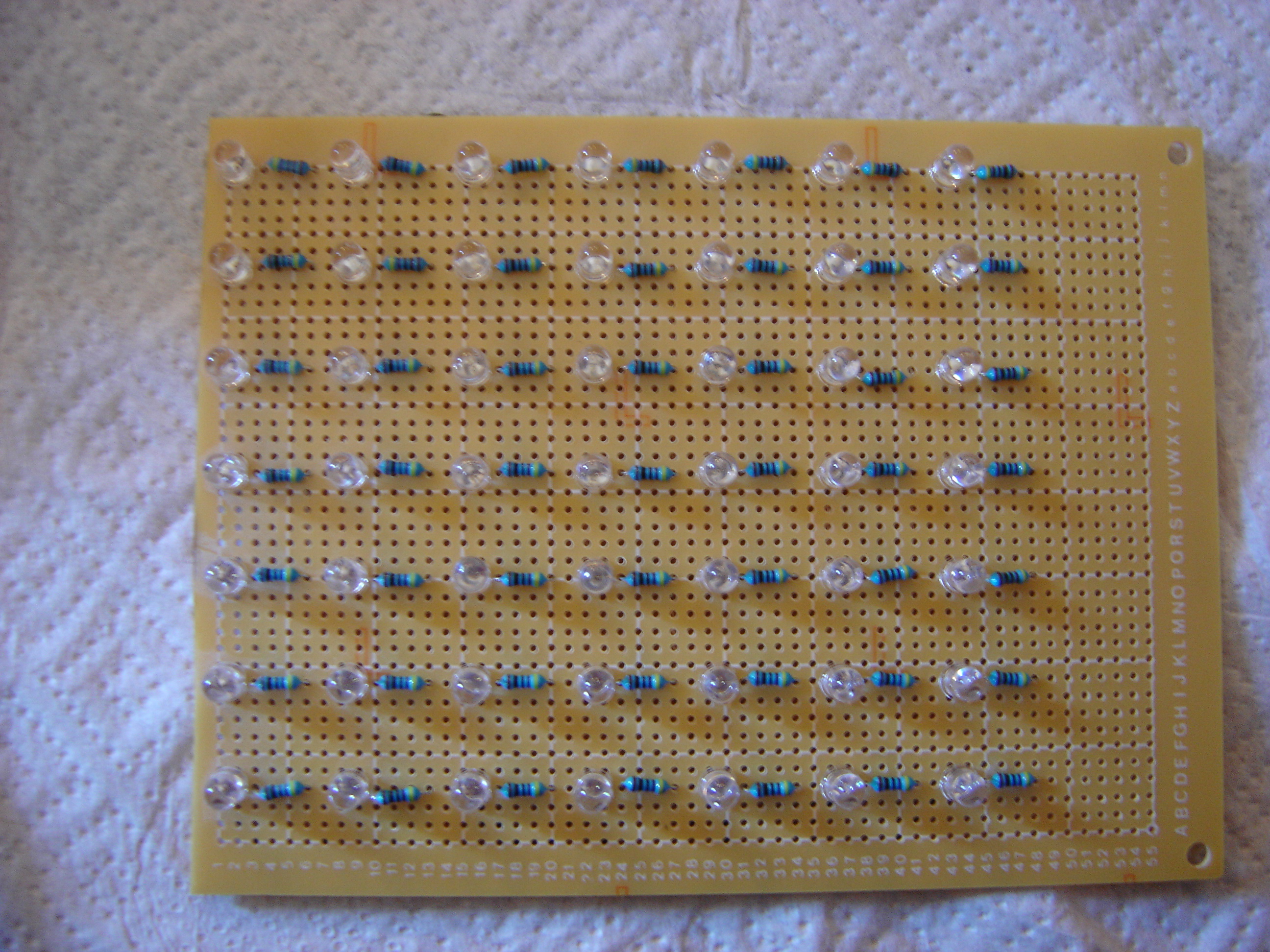
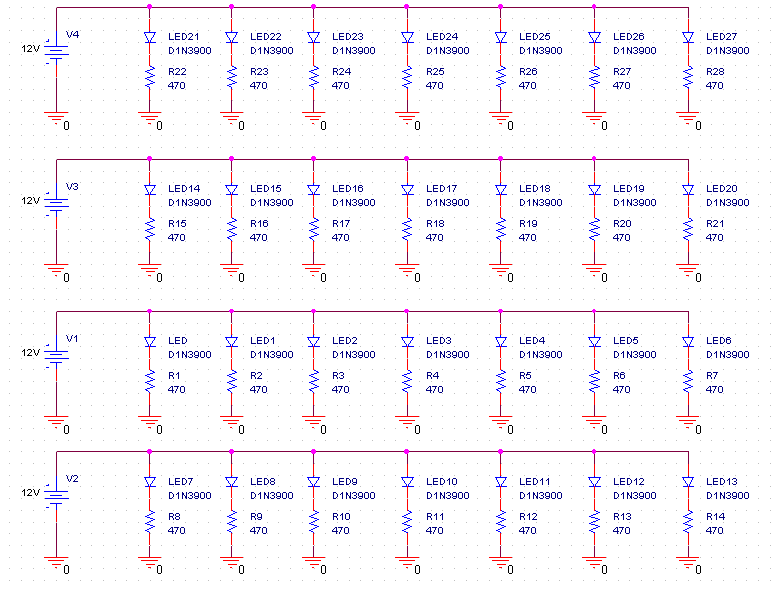
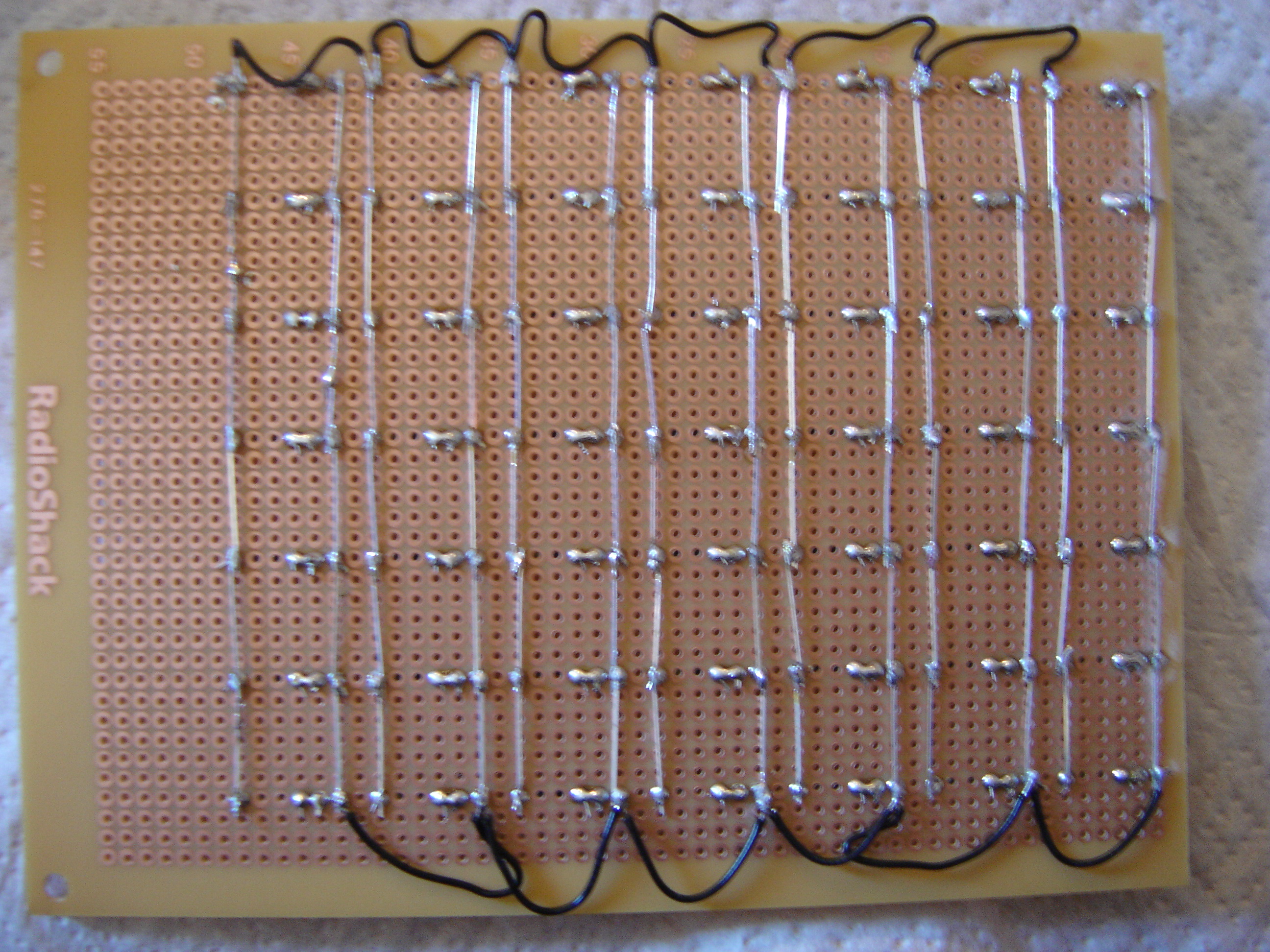
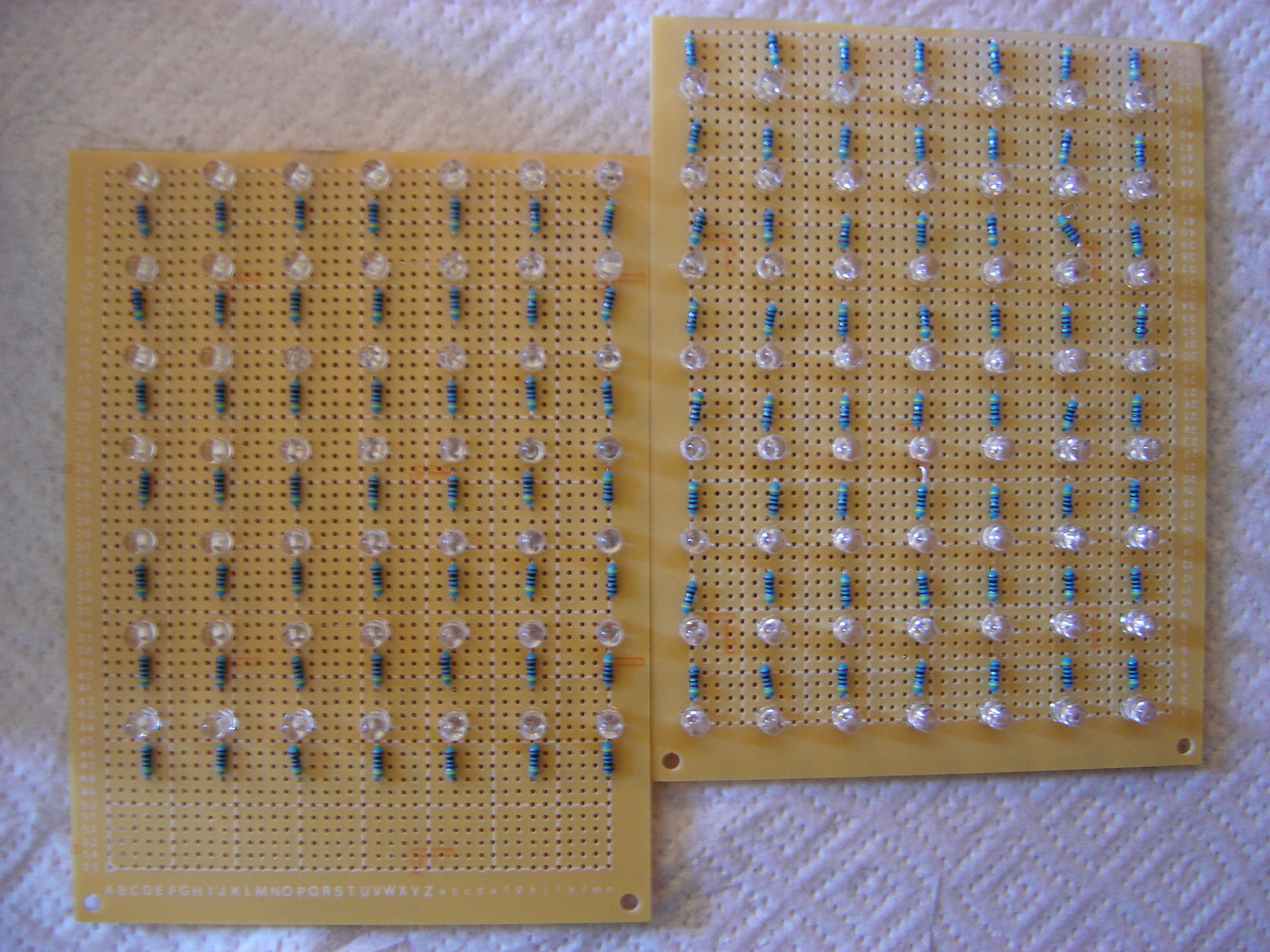
We purchased our chest at Goodwill for $6. We suggest finding a box that is about 1 foot in height.
Elevated transparent plastic/glass is used to hold the transparency paper and presensitized copper clad about 10 inches above the LEDs. The transparent plastic was taken off a picture frame purchased at Goodwill. Keep in mind that some plastics/glass do not allow UV light to pass. Some experimenting is needed to find one that works well.
The picture below shows how Monnie arranged the LEDs on the breadboards purchased at RadioShack. We spaced the LEDs out by 6 holes from all sides.
Banana jacks were inserted in the backside of our box to be powered by a benchtop power supply.
Elevated transparent plastic/glass is used to hold the transparency paper and presensitized copper clad about 10 inches above the LEDs. The transparent plastic was taken off a picture frame purchased at Goodwill. Keep in mind that some plastics/glass do not allow UV light to pass. Some experimenting is needed to find one that works well.
The picture below shows how Monnie arranged the LEDs on the breadboards purchased at RadioShack. We spaced the LEDs out by 6 holes from all sides.
Banana jacks were inserted in the backside of our box to be powered by a benchtop power supply.
Draw Your Circuit Schematic.
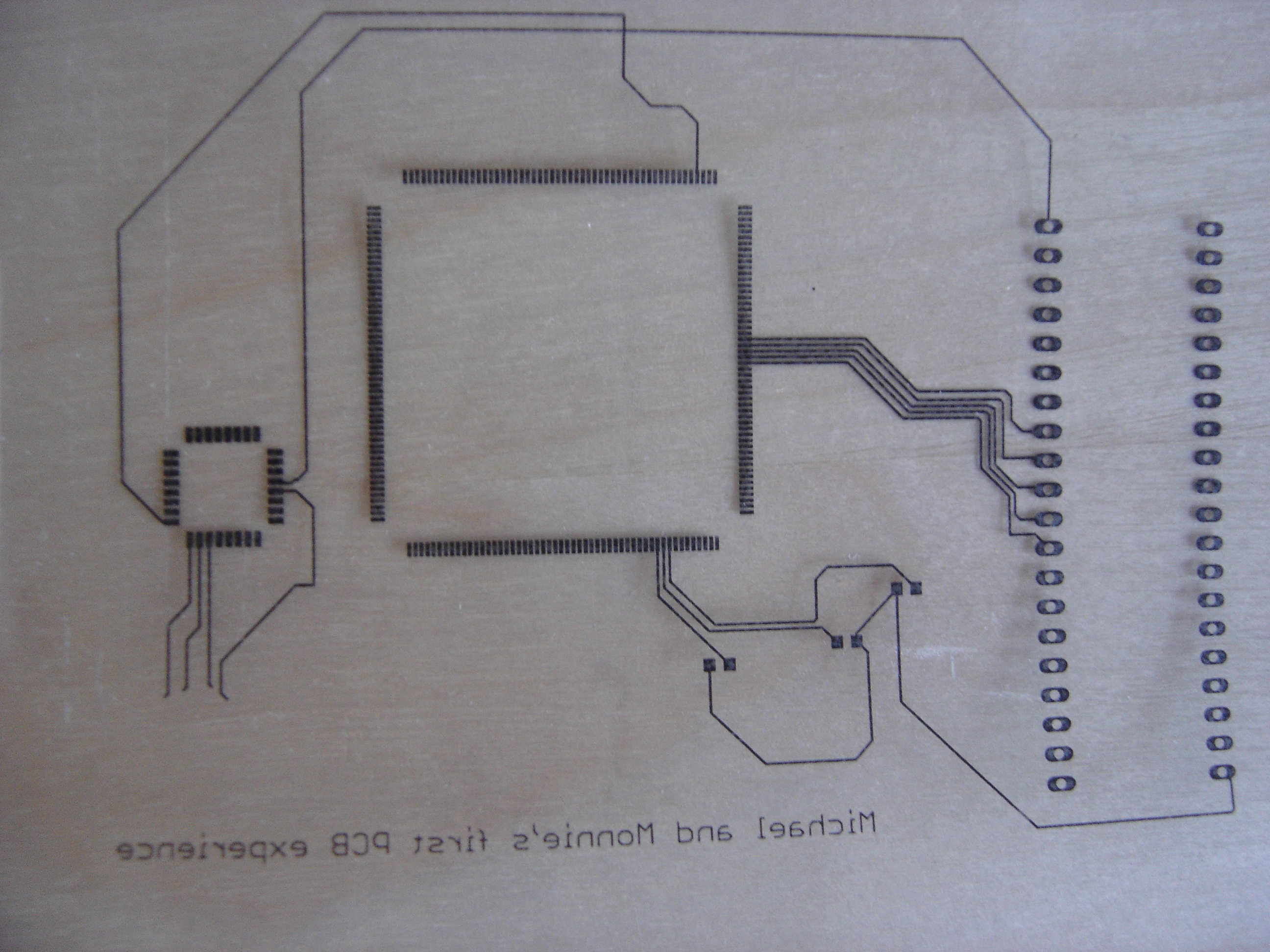
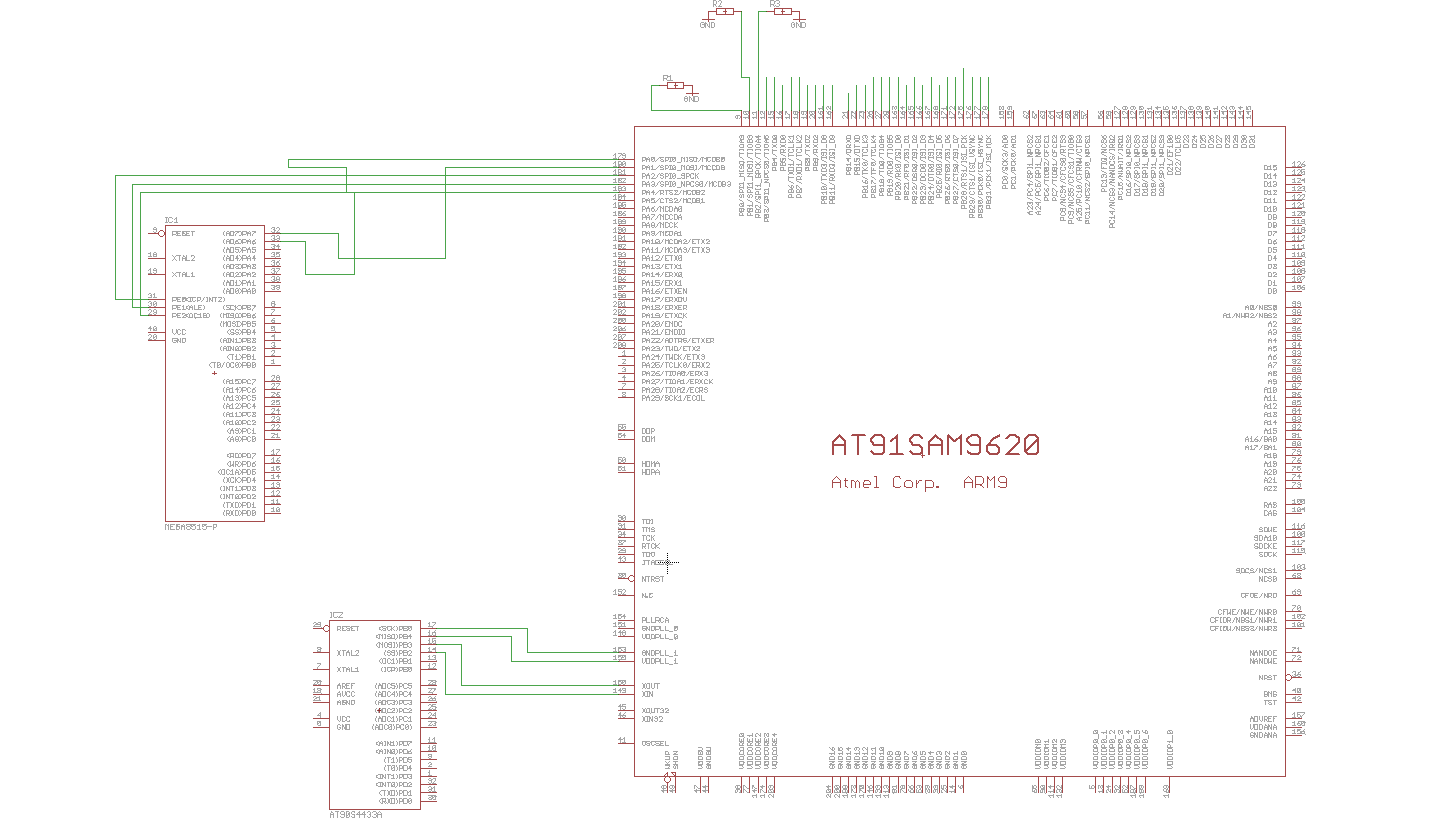
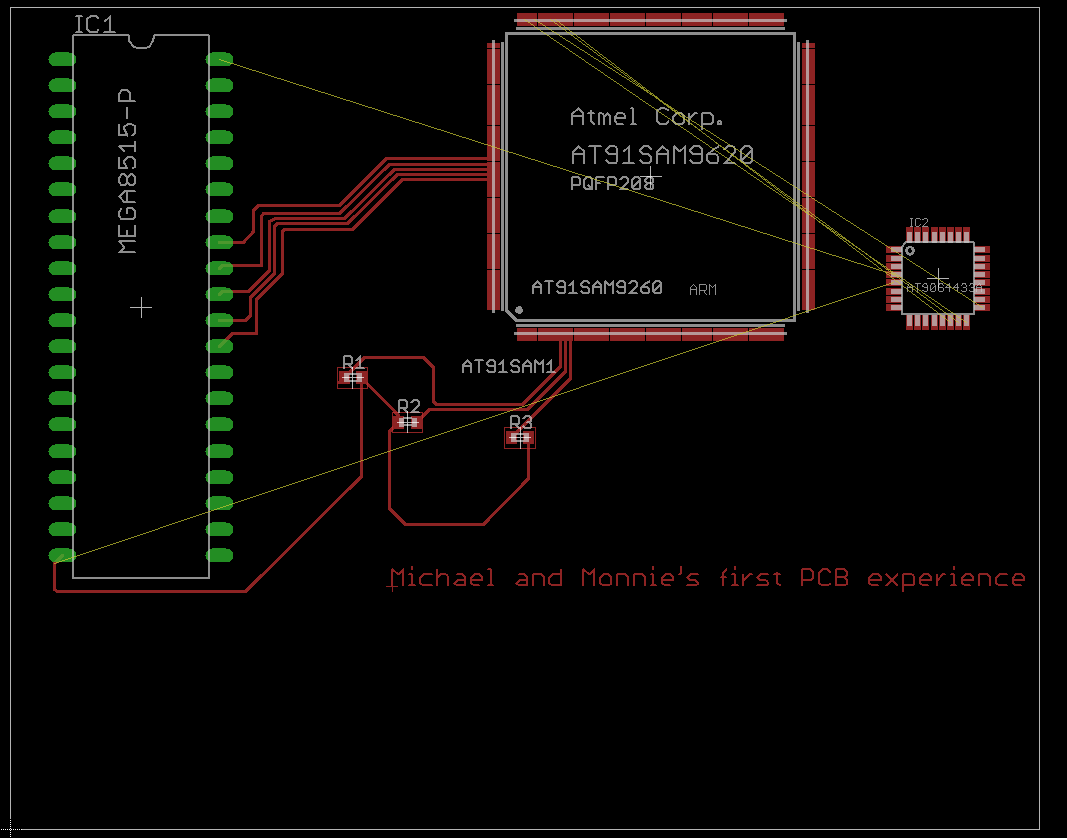
One circuit schematic/layout program that is free is EAGLE. The program can be downloaded from http://www.cadsoftusa.com/
Once the schematic and layout are drawn, it is time to print the layout onto a transparency.
To print only the desired circuit, turn on only the Top Layer, Pads, Vias, and Dimension. This is done by selecting View -> Display/Hide Layers in the Layout editor and selecting the correct settings.
The Layout is now ready to be printed, make sure that the image is mirrored so that text shows up correctly after being transferred onto the PCB. We printed the circuit with our Brother HL-2070N (on highest quality) laser printer and MG Chemicals transparencies.
Note: We originally bought transparencies for inkjet printers and laser printers (one side was textured for use with inkjet printers, the other side was smooth for laser printers). We had read a PCB tutorial where the guy used the textured transparency paper without problem. From our experience, the textured side did NOT allow UV light to pass through. Only use transparency paper with smooth surfaces.)
Once the schematic and layout are drawn, it is time to print the layout onto a transparency.
To print only the desired circuit, turn on only the Top Layer, Pads, Vias, and Dimension. This is done by selecting View -> Display/Hide Layers in the Layout editor and selecting the correct settings.
The Layout is now ready to be printed, make sure that the image is mirrored so that text shows up correctly after being transferred onto the PCB. We printed the circuit with our Brother HL-2070N (on highest quality) laser printer and MG Chemicals transparencies.
Note: We originally bought transparencies for inkjet printers and laser printers (one side was textured for use with inkjet printers, the other side was smooth for laser printers). We had read a PCB tutorial where the guy used the textured transparency paper without problem. From our experience, the textured side did NOT allow UV light to pass through. Only use transparency paper with smooth surfaces.)
Expose the Presensitized Circuit Board to UV Light.
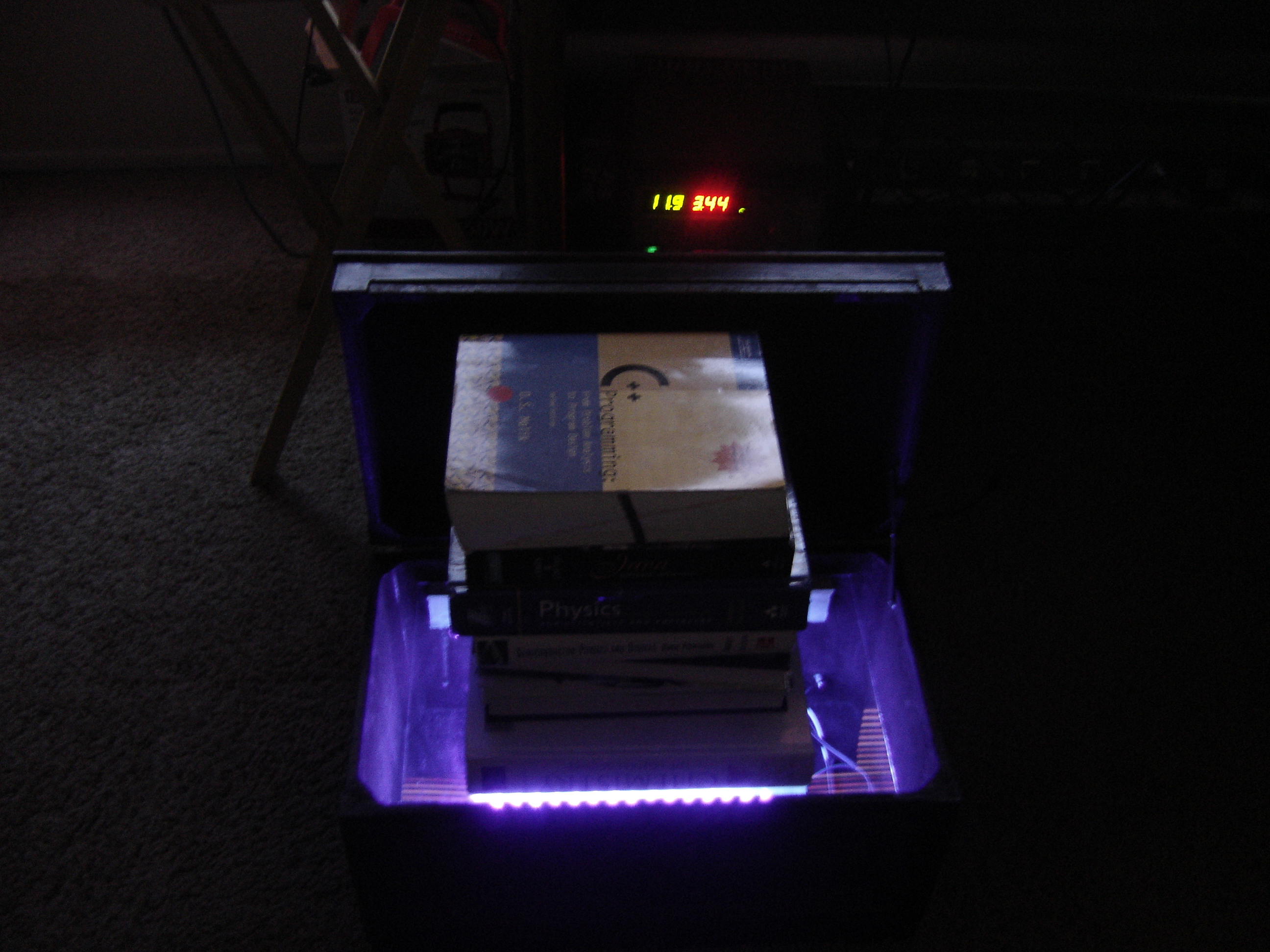
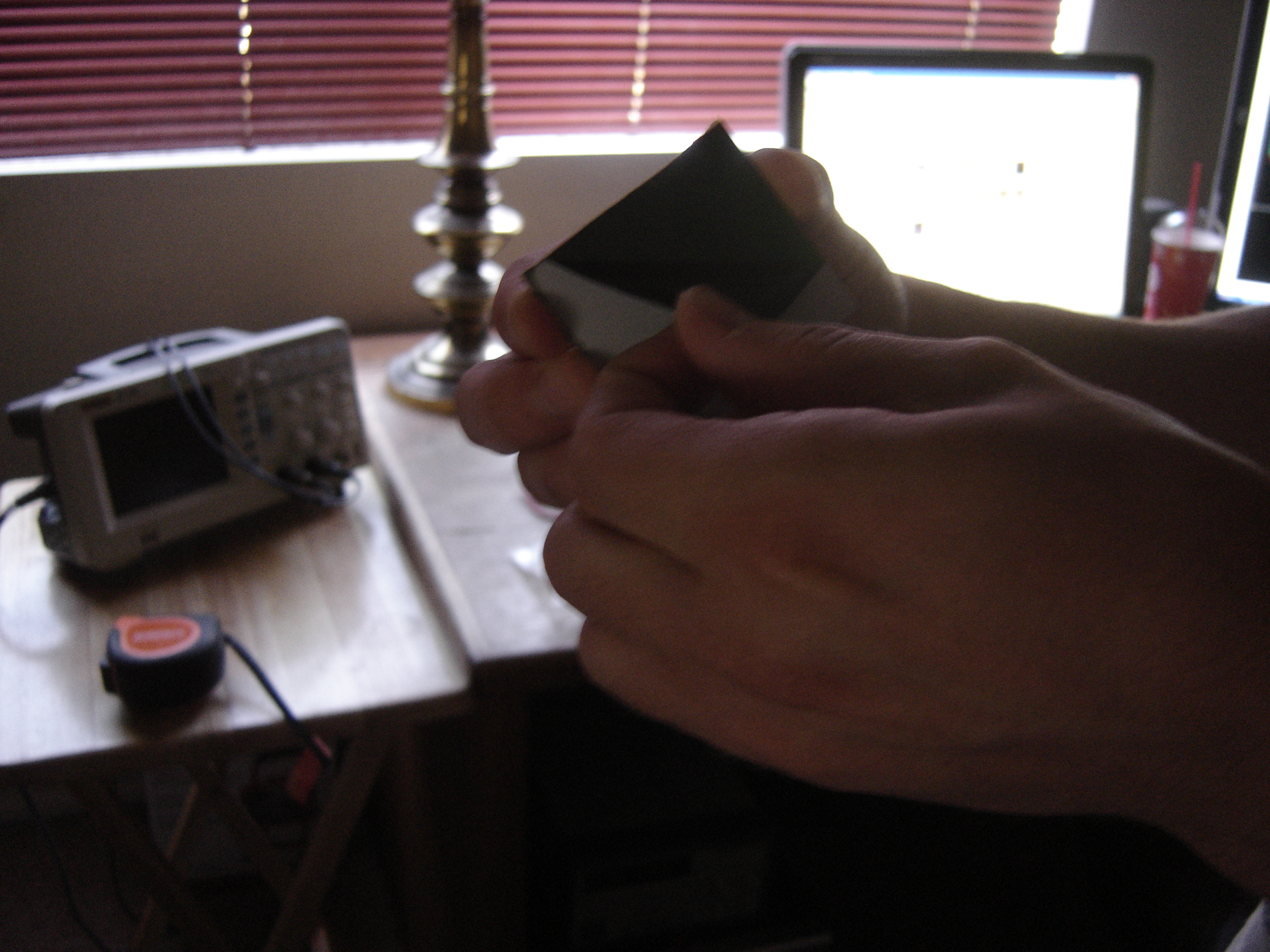
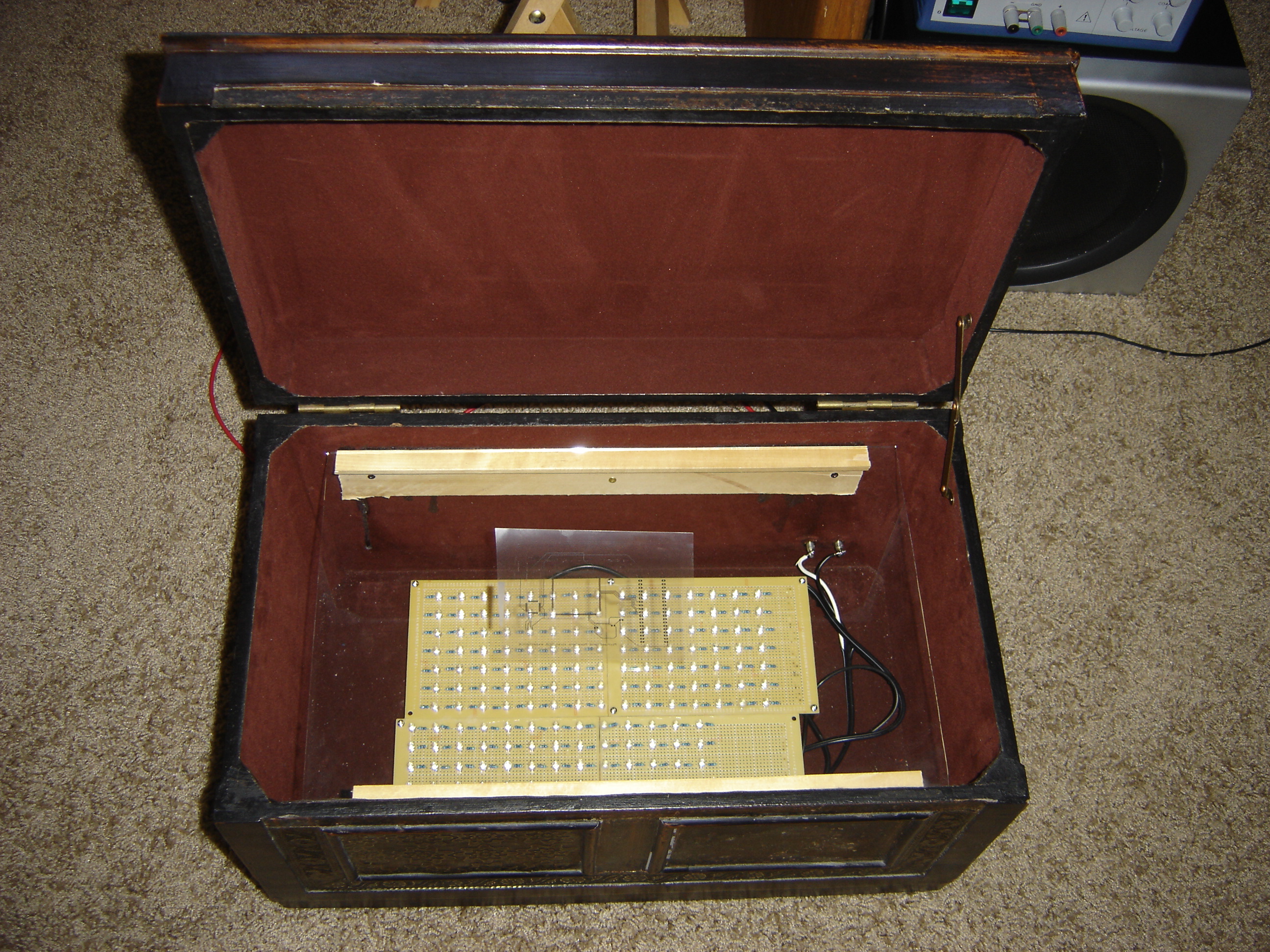
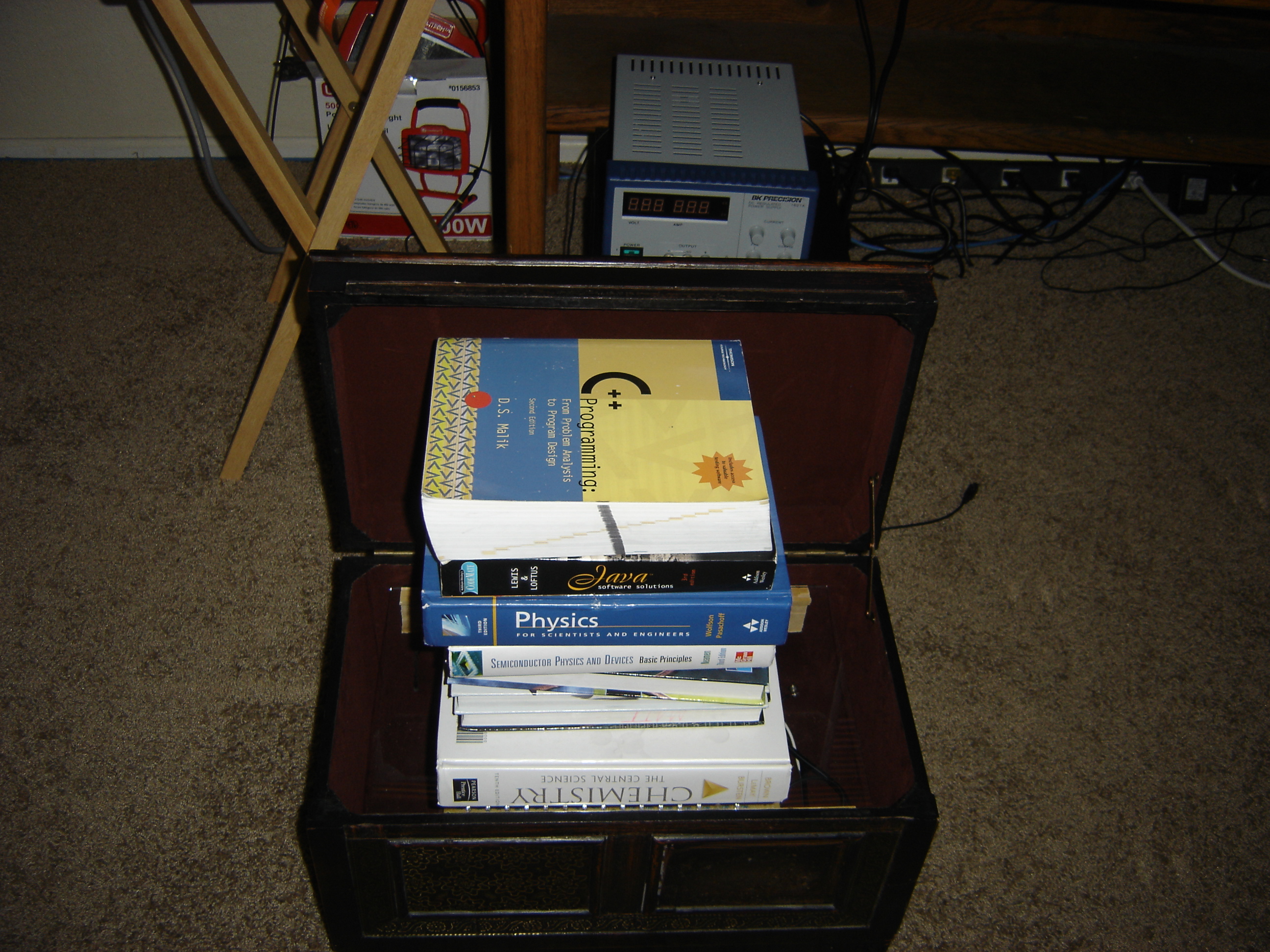
Place the printed transparency on the elevated plastic about 10 inches above the LEDs. The ink should be facing up towards the sky. While the room is somewhat dark, peel the white film off the presensitized circuit board to expose the photoresist. Place the PCB on top of the transparency, photoresist facing down towards the LEDs. Stack about 8-10 textbooks on top of the PCB to make sure the photoresist is tightly pressed against the ink of the transparency. No scotch tape is necessary to hold the PCB down to the transparency.
Turn the UV light box on. We found that exactly 1 minute exposure time worked well. You may have to experiment with different times depending on the height above the LEDs. Turn off after 1 minute.
The photoresist will look exactly the same after it has been exposed to UV light. We could not tell the difference between an exposed board and a non-exposed board.
Note: The first time you attempt to make a PCB, you will most likely fail (we failed literally about 40 times. Darn textured transparency paper!). We suggest buying a large PCB and cutting it into small squares with a Dremel (I also read a paper cutter works fine). This will save you a lot of money.
Turn the UV light box on. We found that exactly 1 minute exposure time worked well. You may have to experiment with different times depending on the height above the LEDs. Turn off after 1 minute.
The photoresist will look exactly the same after it has been exposed to UV light. We could not tell the difference between an exposed board and a non-exposed board.
Note: The first time you attempt to make a PCB, you will most likely fail (we failed literally about 40 times. Darn textured transparency paper!). We suggest buying a large PCB and cutting it into small squares with a Dremel (I also read a paper cutter works fine). This will save you a lot of money.
Prepare the Developer Solution.
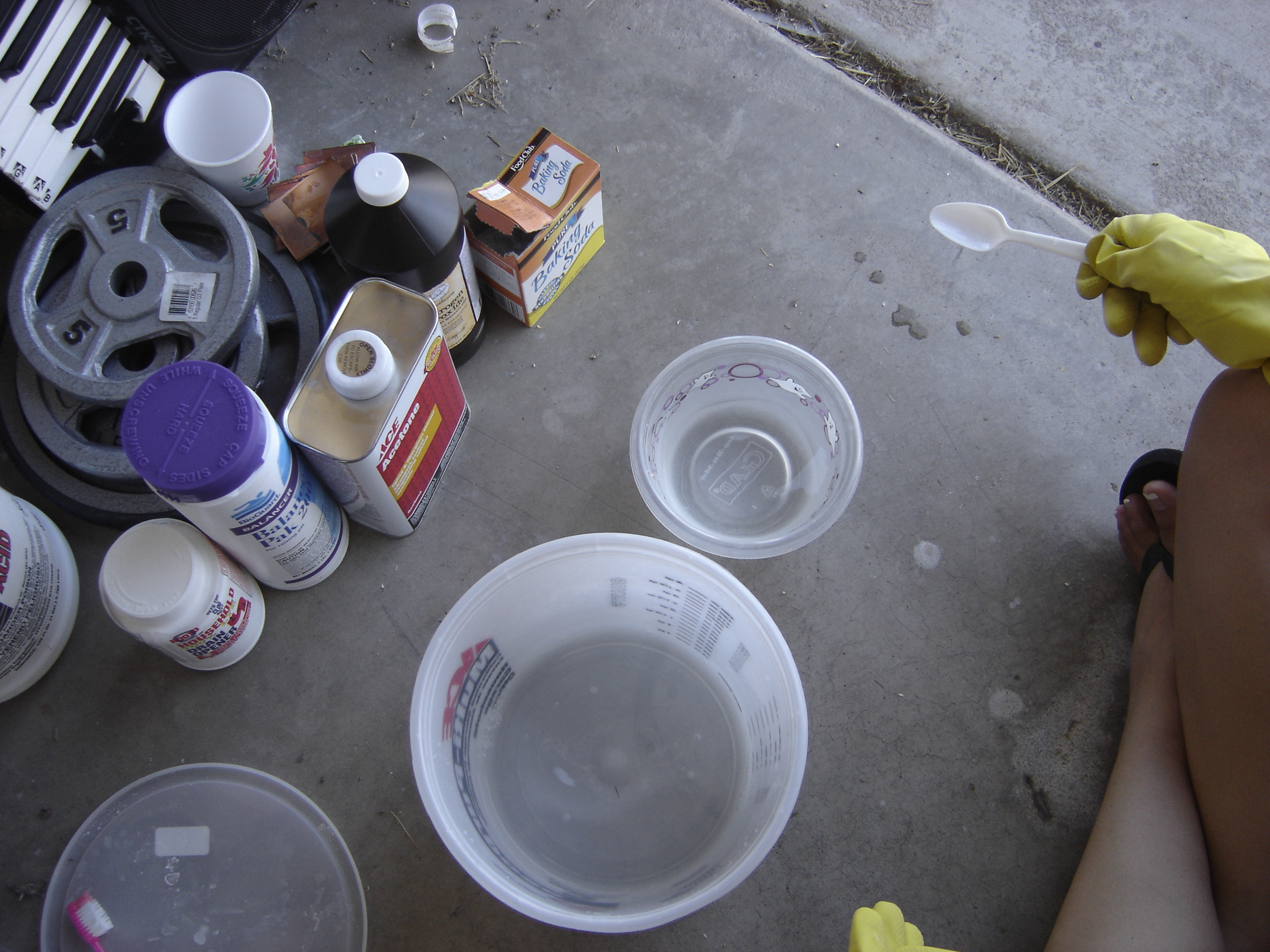
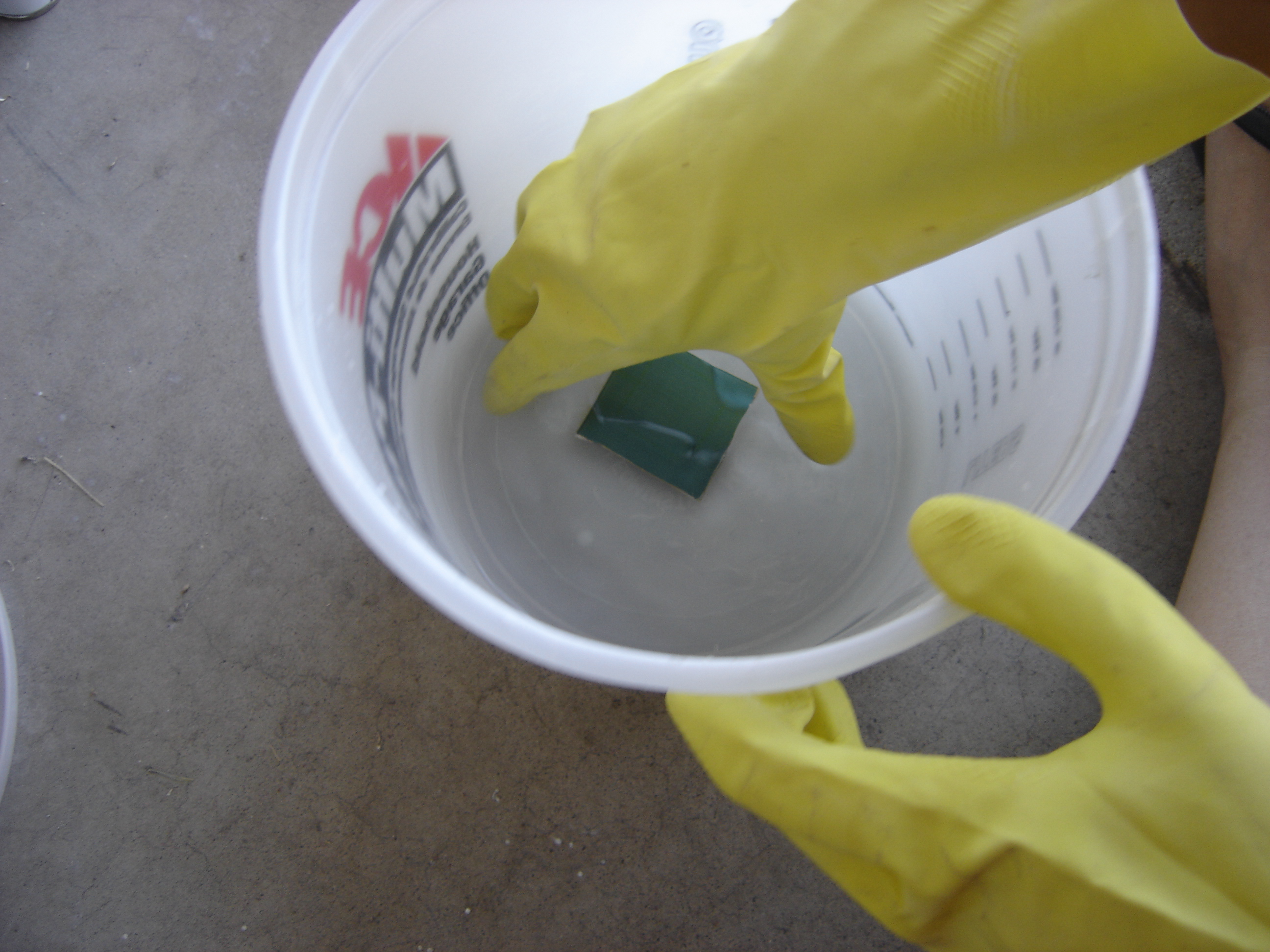
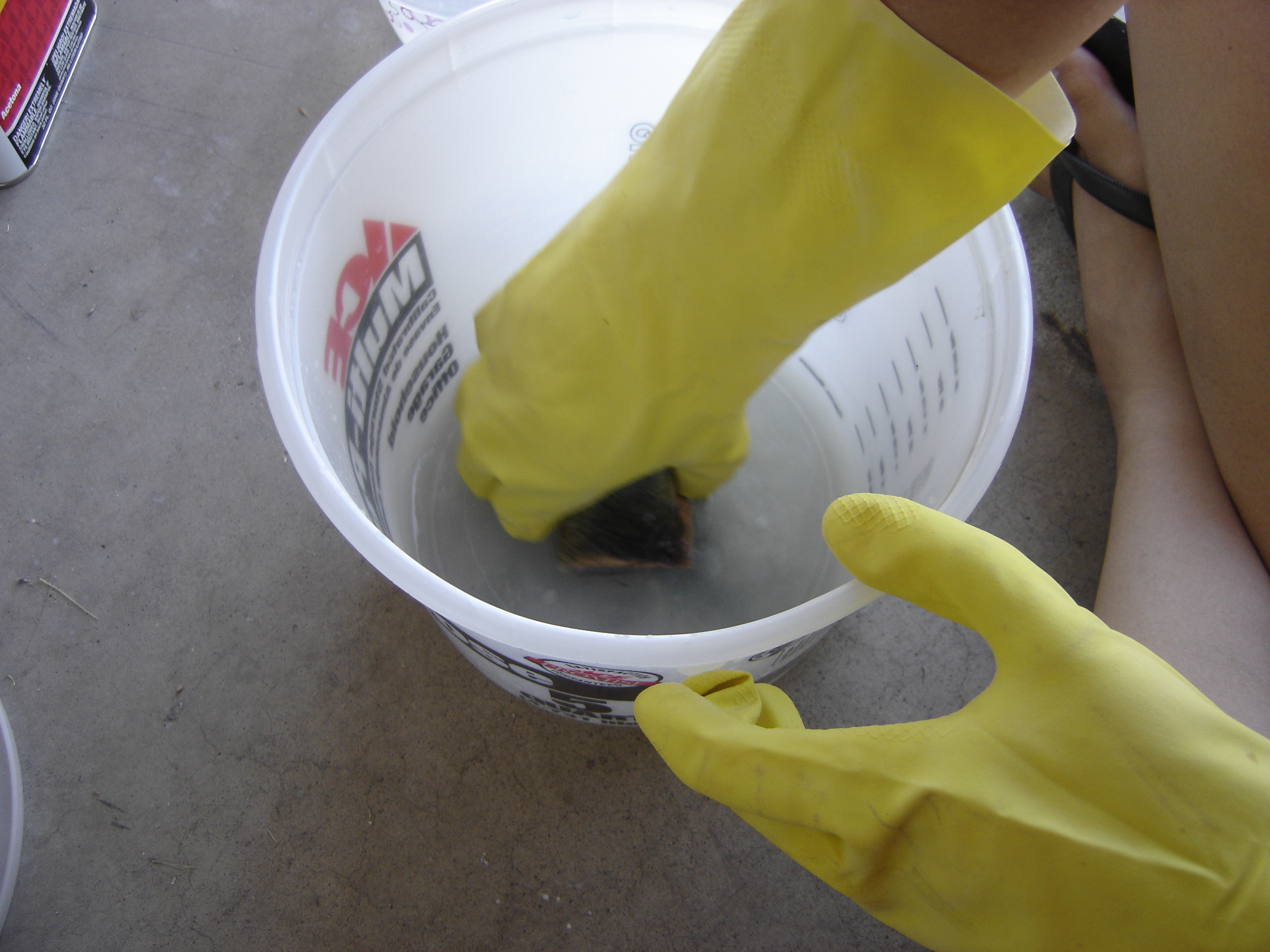
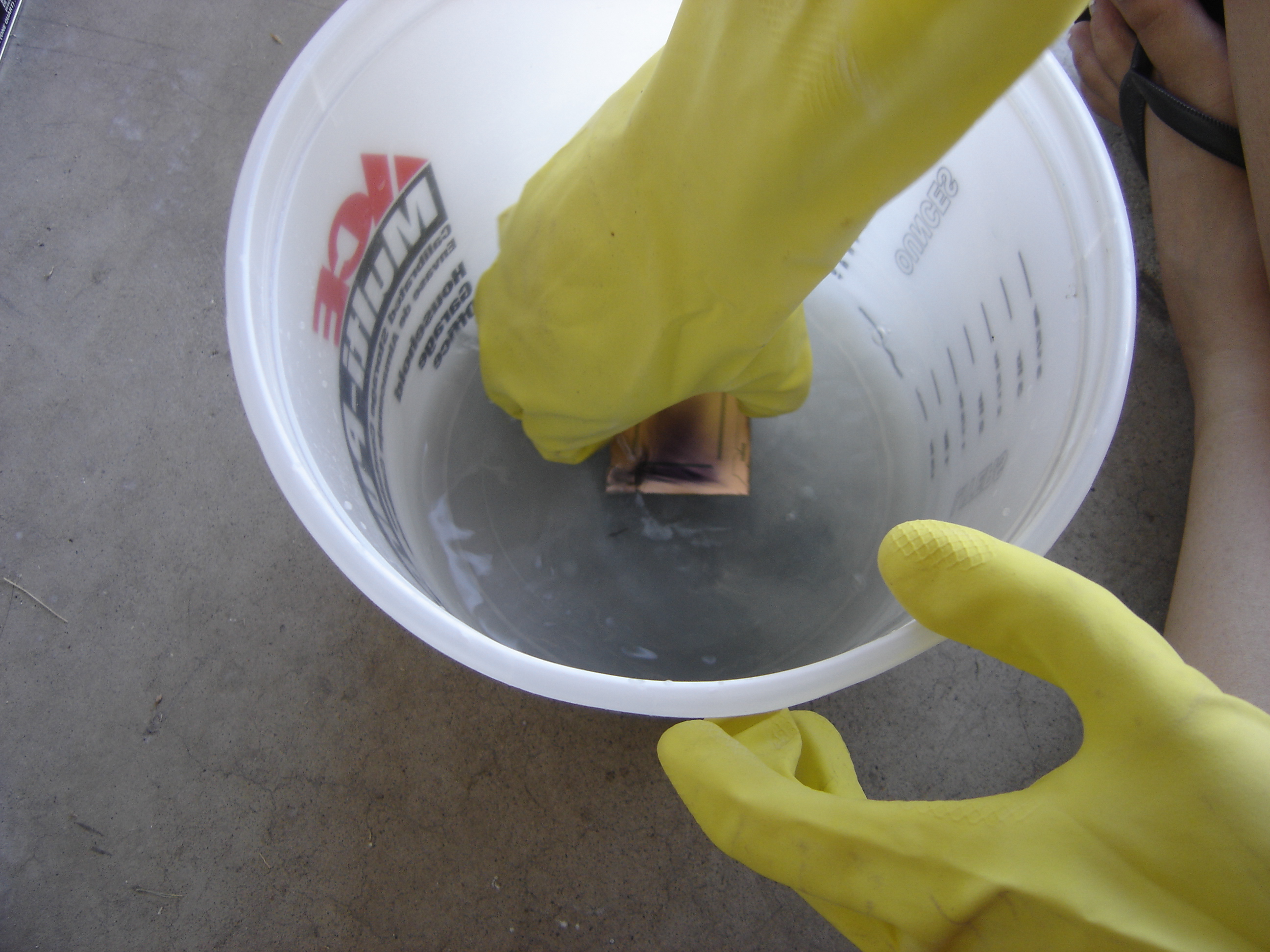
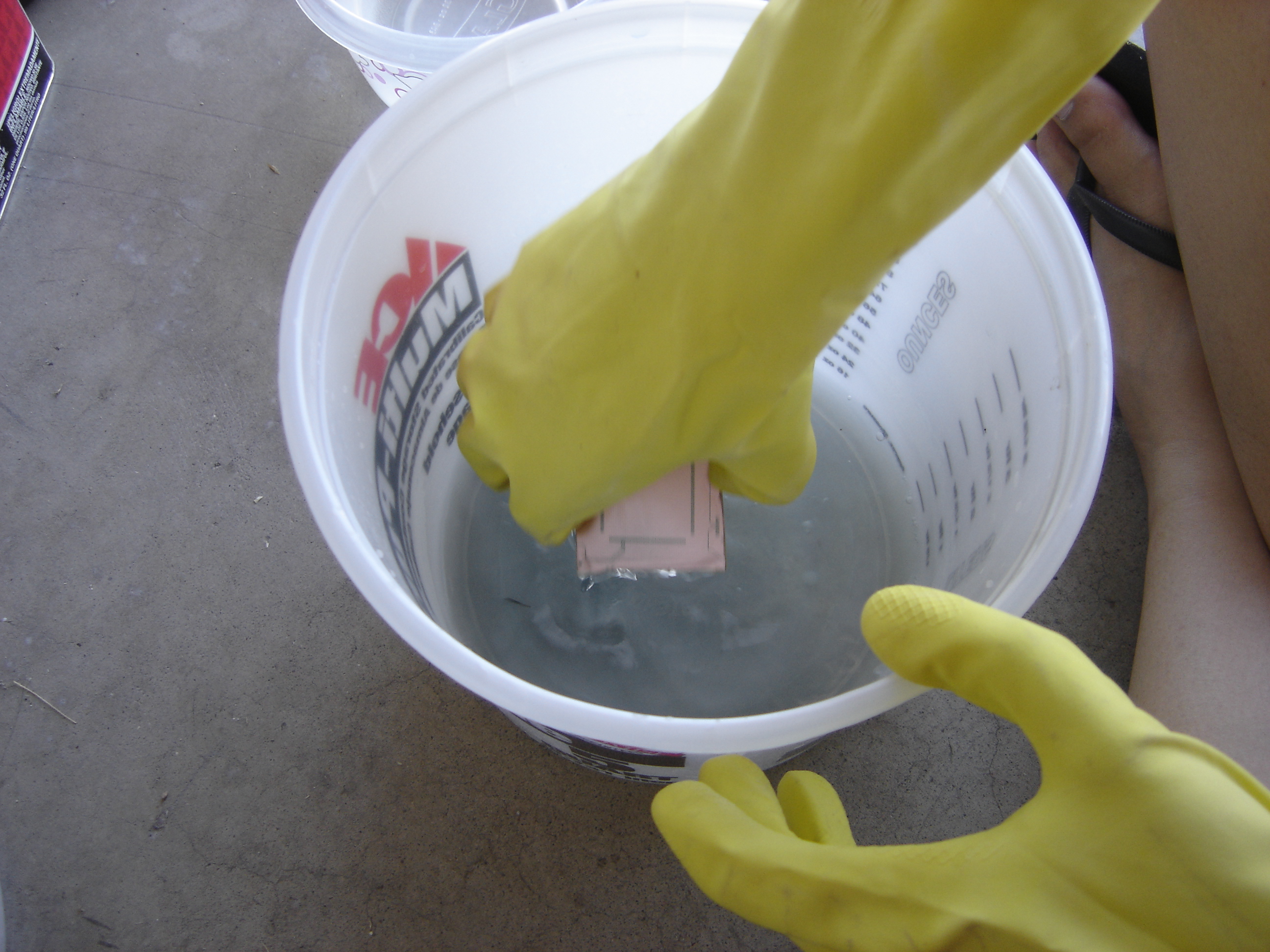

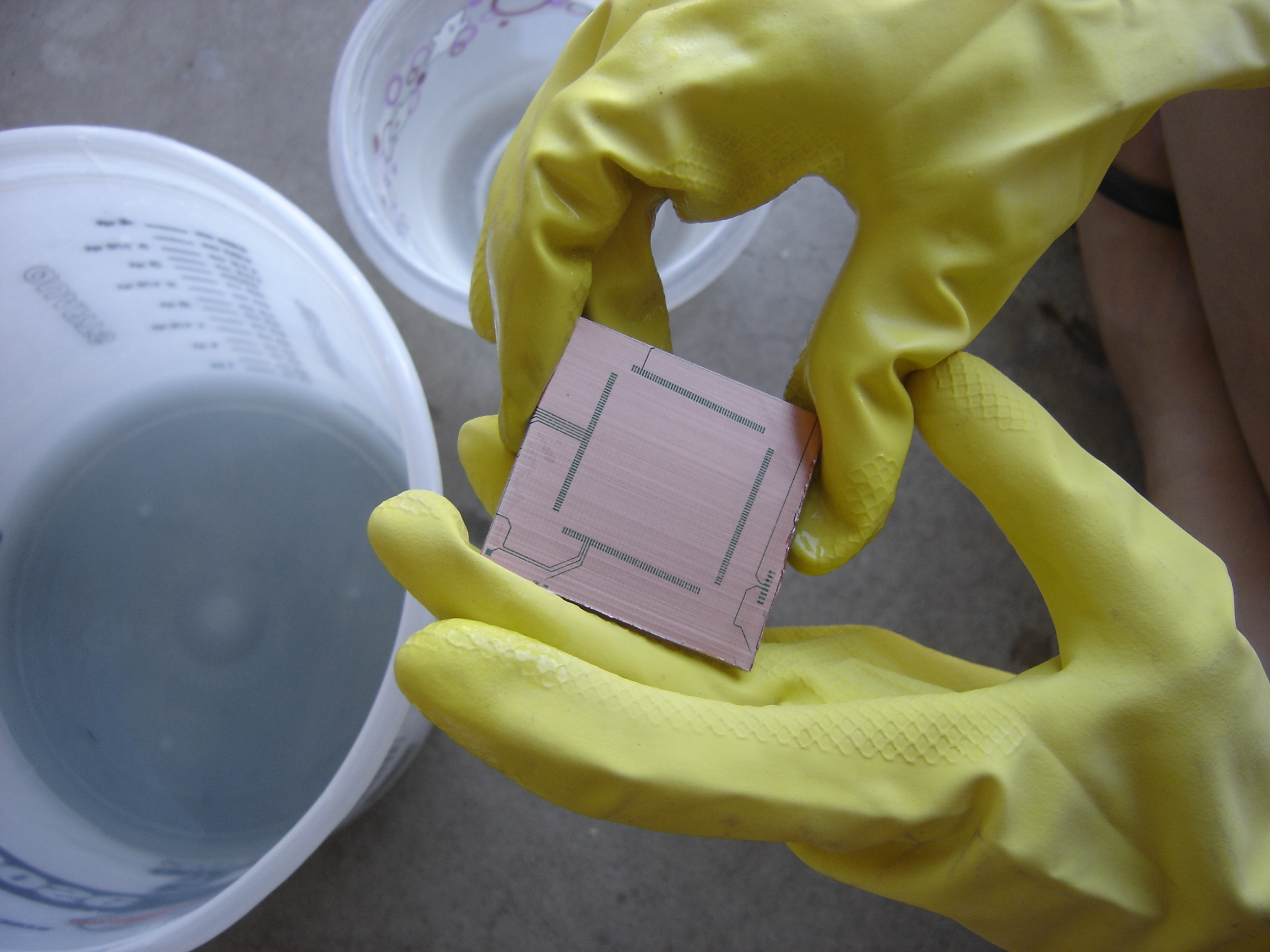
Prepare the MG Chemical developer solution with 1 part developer, 10 parts tap water. I used 1/4 cup developer, 2 1/2 cups of tap water. Be sure to mix the solution with tap water thoroughly before placing the PCB in the solution, otherwise the photoresist will be eaten away in undesired spots.
Place the PCB in the mixed solution and shake it around face up. The parts where the photoresist was exposed to UV light will be washed away in about 5-10 seconds. Do not leave the board in the developer solution for too long, otherwise all the photoresist will be washed away. Place the PCB in cold water immediately to stop the reaction once the board is finished.
The developer solution can be re-used for multiple PCBs.
Note: The solution is dangerous to skin and eyes. We suggest wearing gloves and goggles.
Note: We tried all sorts of chemicals to eat away at the photoresist. We found that the MG Chemical brand developer worked the best. You could also try using Sodium Hydroxide (Lye from Ace Hardware) but you will have to experiment with what % to put in tap water. The percentage of Sodium Hydroxide to tap water is important because too strong of a solution will wash away your non-exposed UV photoresist.
Place the PCB in the mixed solution and shake it around face up. The parts where the photoresist was exposed to UV light will be washed away in about 5-10 seconds. Do not leave the board in the developer solution for too long, otherwise all the photoresist will be washed away. Place the PCB in cold water immediately to stop the reaction once the board is finished.
The developer solution can be re-used for multiple PCBs.
Note: The solution is dangerous to skin and eyes. We suggest wearing gloves and goggles.
Note: We tried all sorts of chemicals to eat away at the photoresist. We found that the MG Chemical brand developer worked the best. You could also try using Sodium Hydroxide (Lye from Ace Hardware) but you will have to experiment with what % to put in tap water. The percentage of Sodium Hydroxide to tap water is important because too strong of a solution will wash away your non-exposed UV photoresist.
Etch the Copper Away.
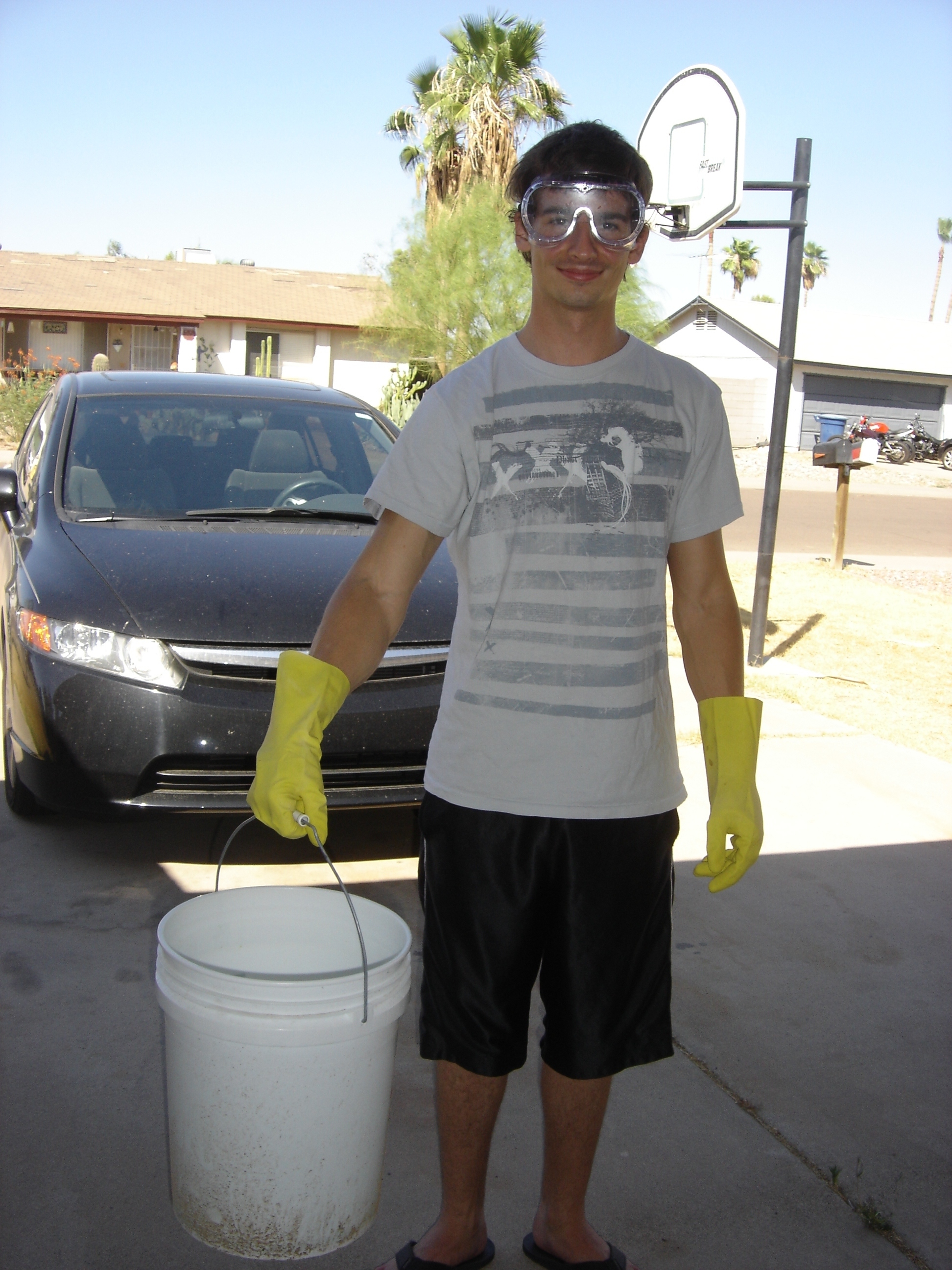
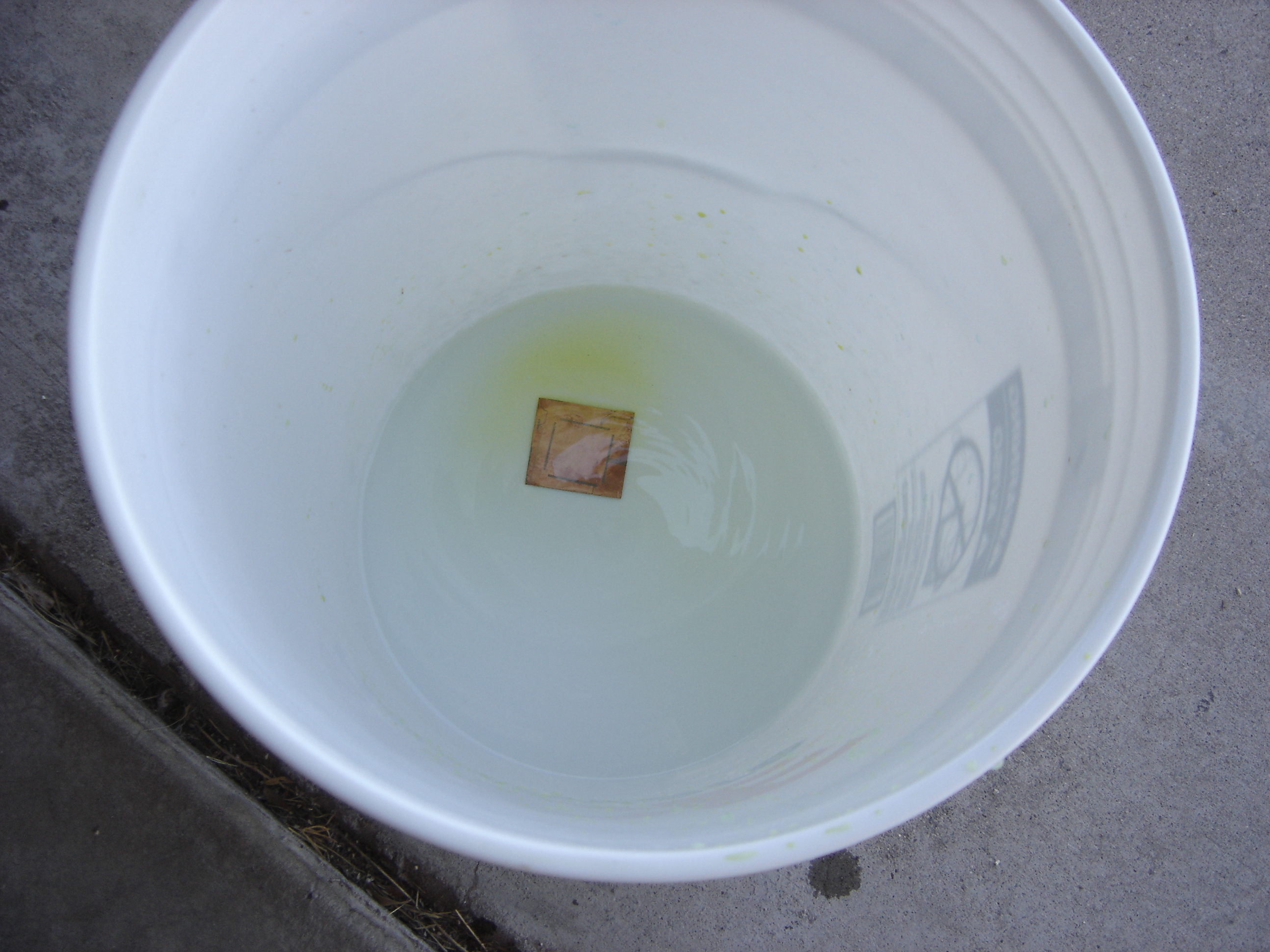
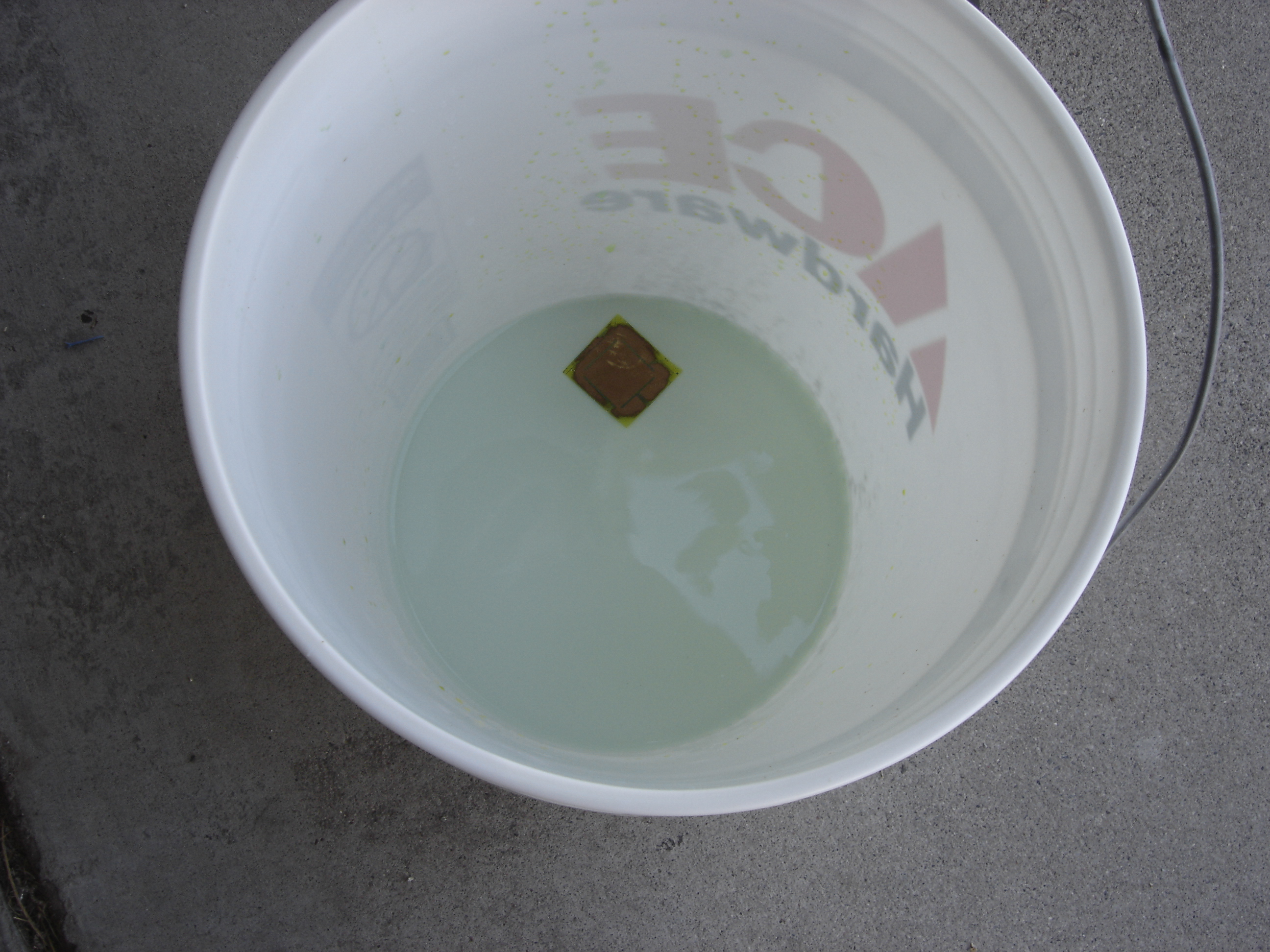
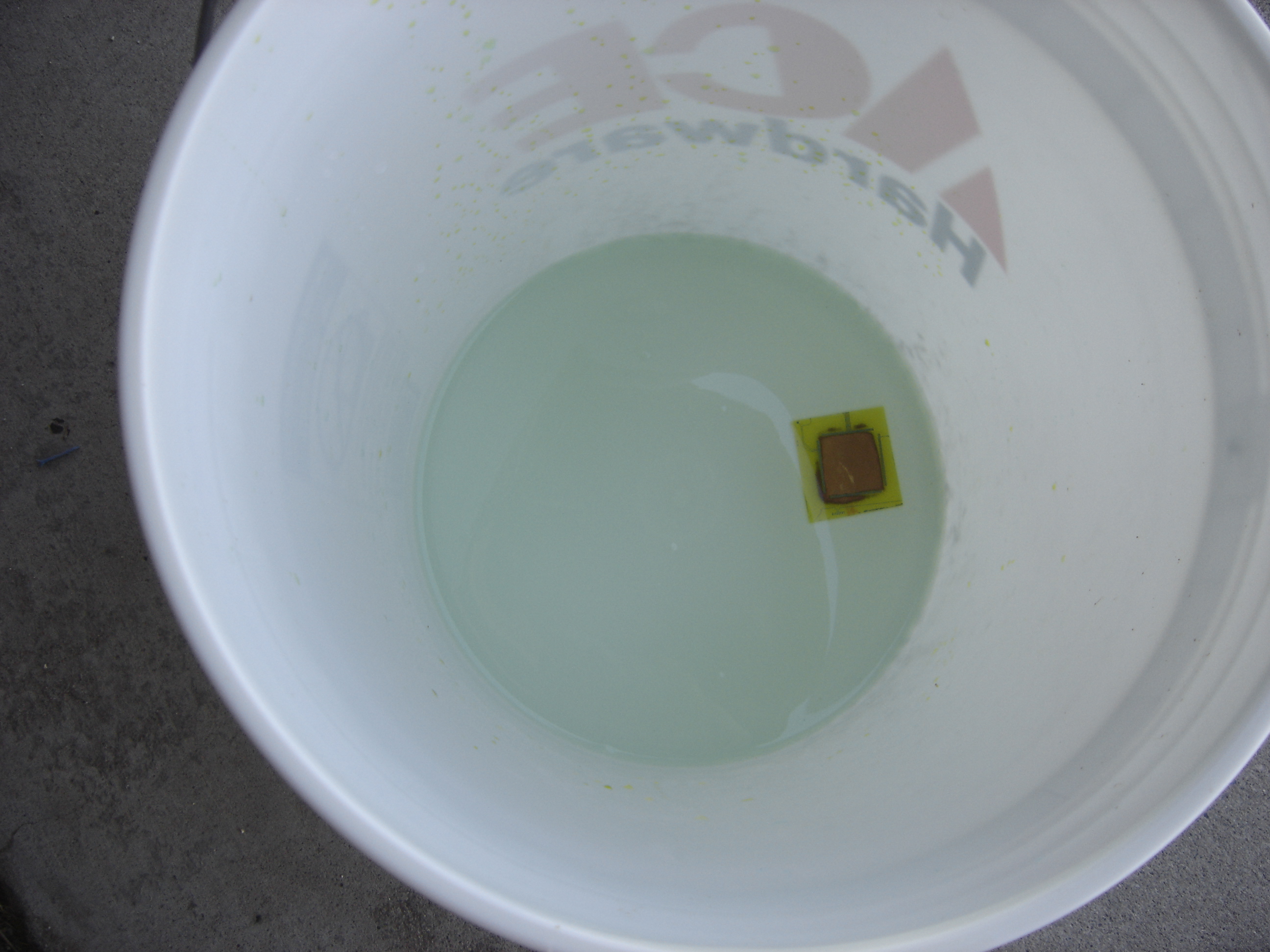
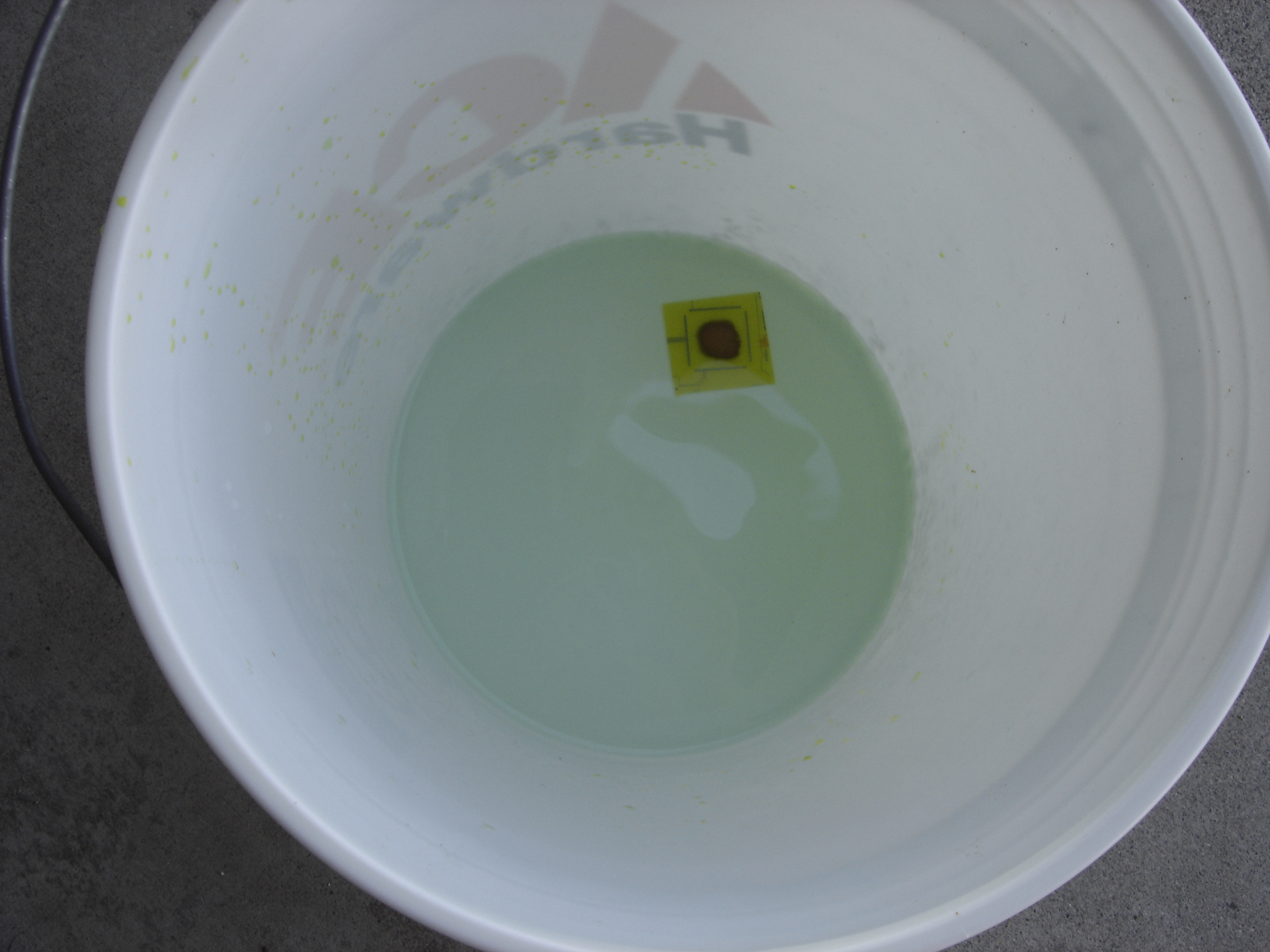
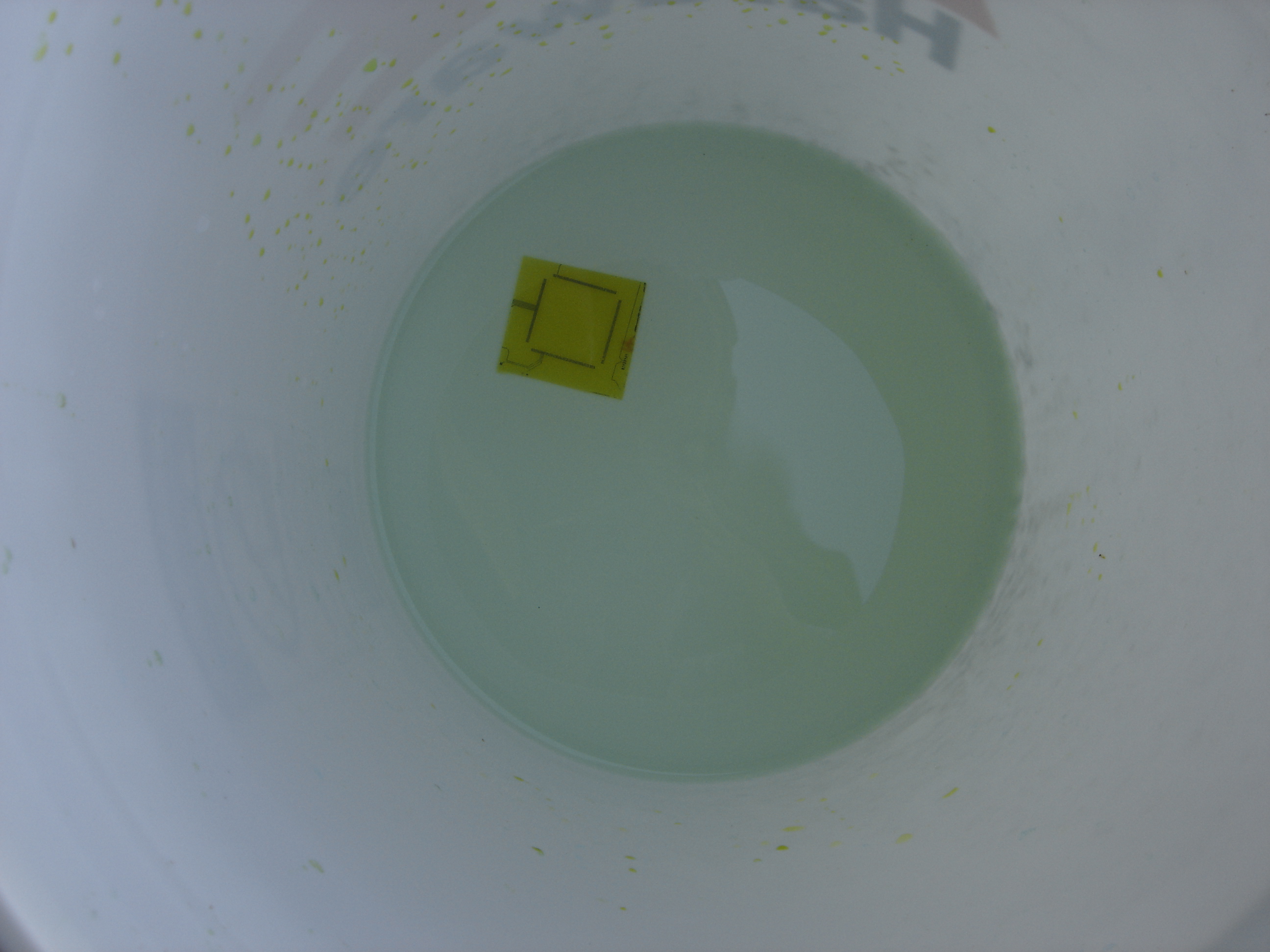
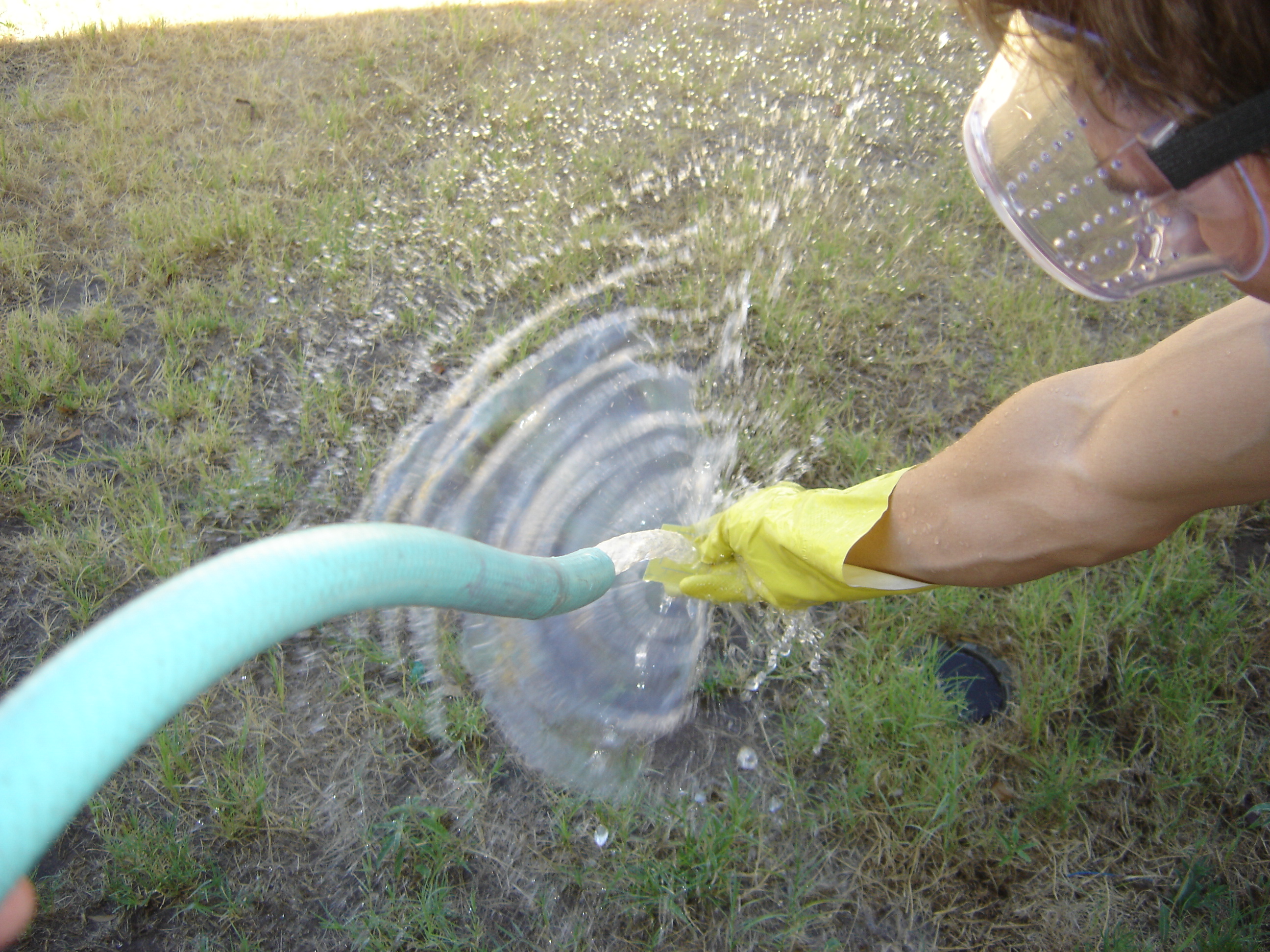
Prepare a solution of 1 part Muriatic Acid, 2 parts hydrogen peroxide. I used 8 oz. Muriatic acid, 16 oz. hydrogen peroxide. Be very careful with this acid, it's a lot stronger than the photoresist developer. I suggest using a fan over the bucket so you don't breathe in any of the fumes. Wear gloves and goggles.
Add the PCB to the solution and shake the bucket carefully. The solution will start to turn green as the copper is being etched away. As soon as all the copper is etched away, remove it from the bucket. The copper will take about 2 minutes to be etched away completely.
Wash the PCB off in a bucket or use a hose.
Add the PCB to the solution and shake the bucket carefully. The solution will start to turn green as the copper is being etched away. As soon as all the copper is etched away, remove it from the bucket. The copper will take about 2 minutes to be etched away completely.
Wash the PCB off in a bucket or use a hose.
Remove the Photoresist
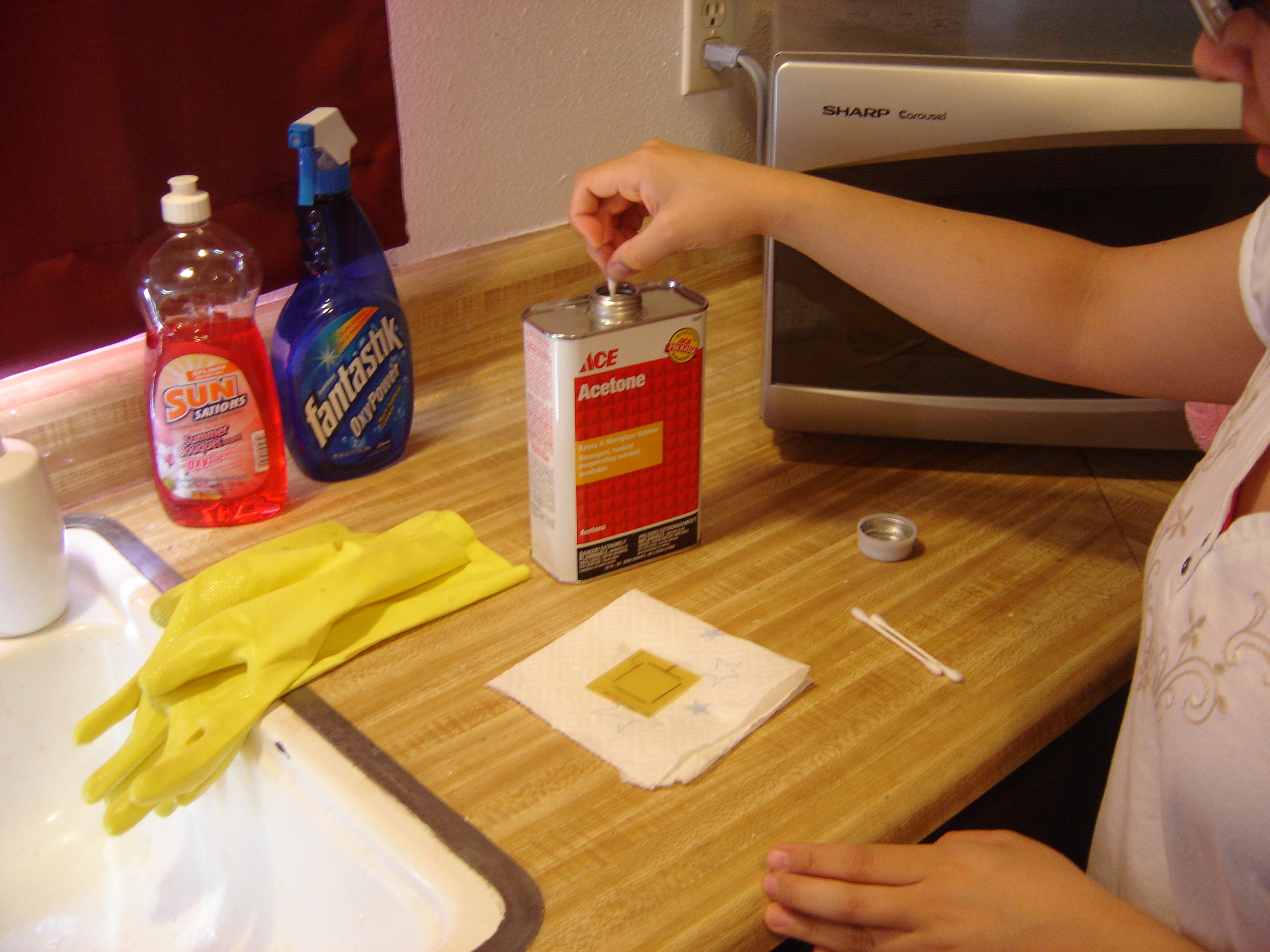
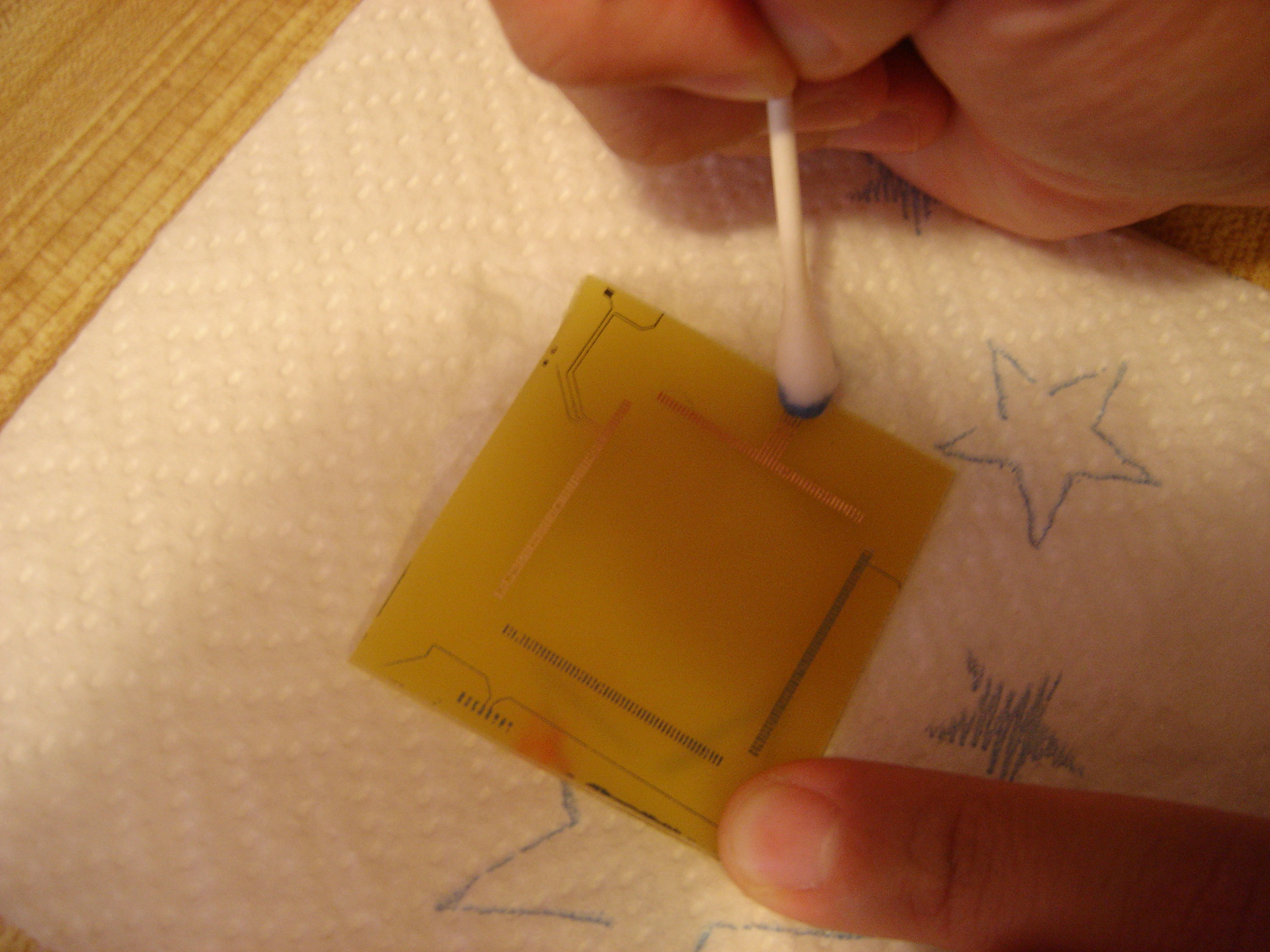
Remove the photoresist with Acetone and a Q-tip. The photoresist will come off very easily with a Q-tip dipped in Acetone. Keep using new Q-tips until the Q-tips are white after you have swabbed the board.
Populate Your PCB With Parts
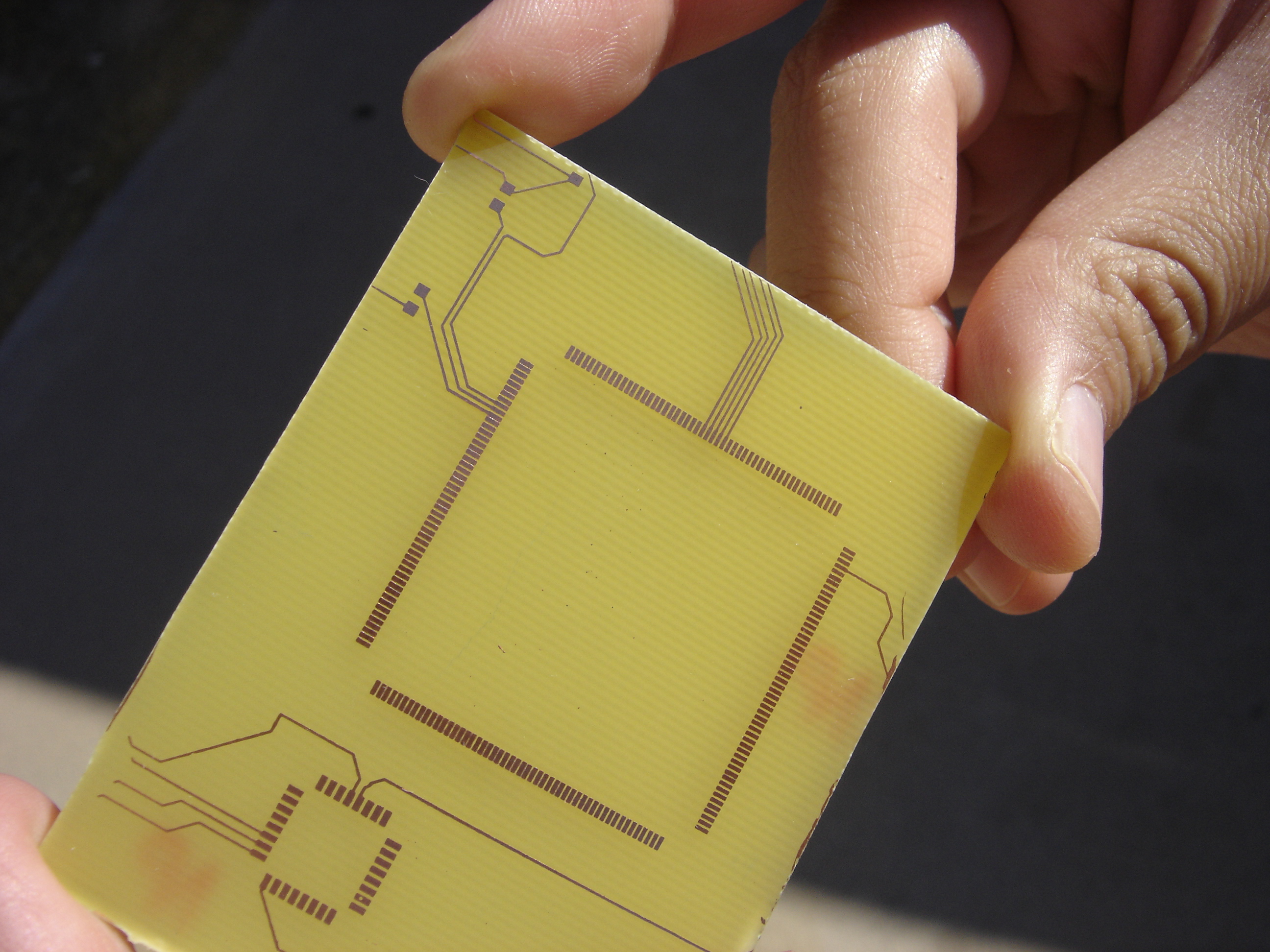
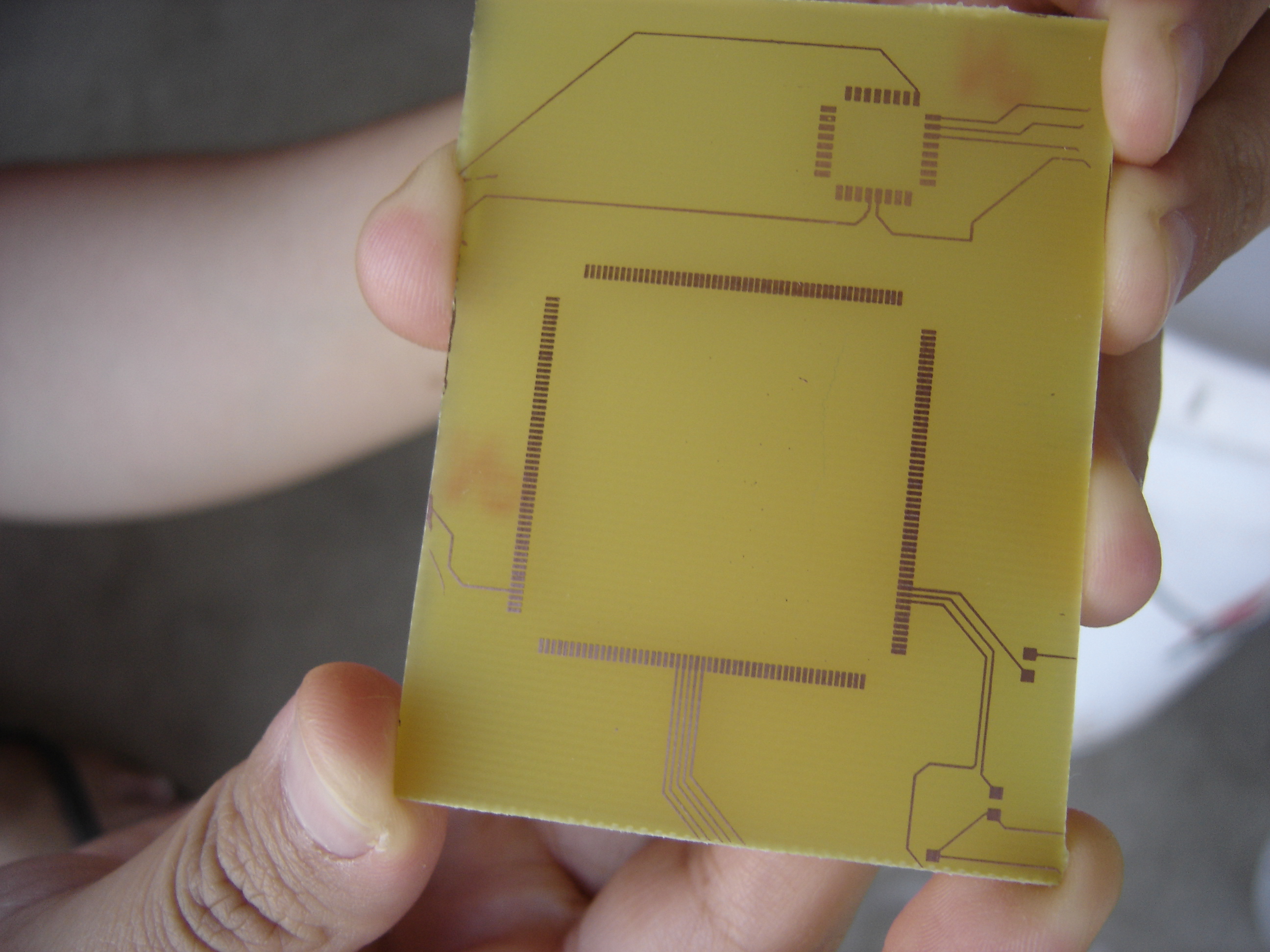
At this point, you have a PCB to populate with integrated circuits and parts. Enjoy your PCB and let me know if you have any questions.
Mistakes
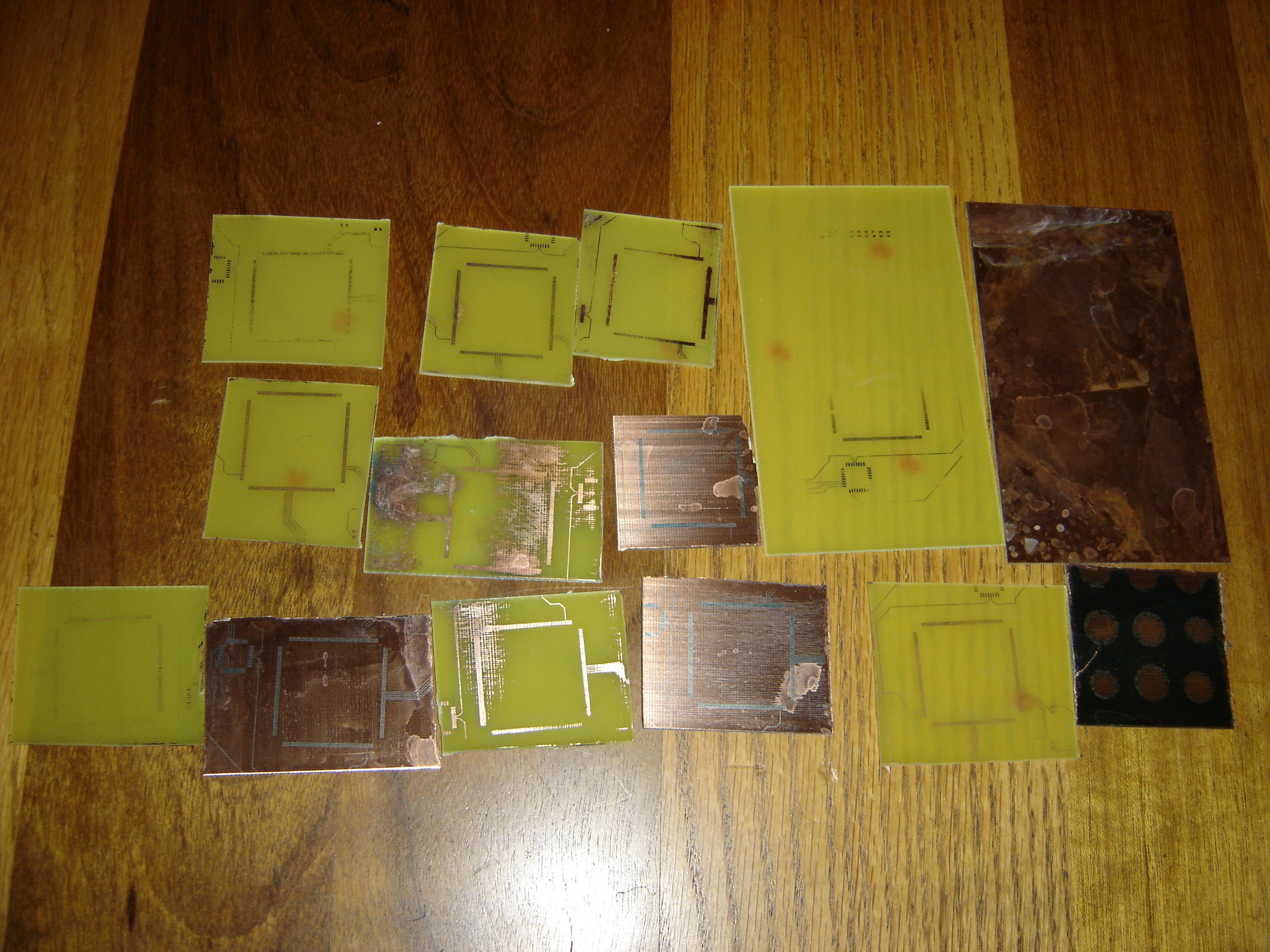
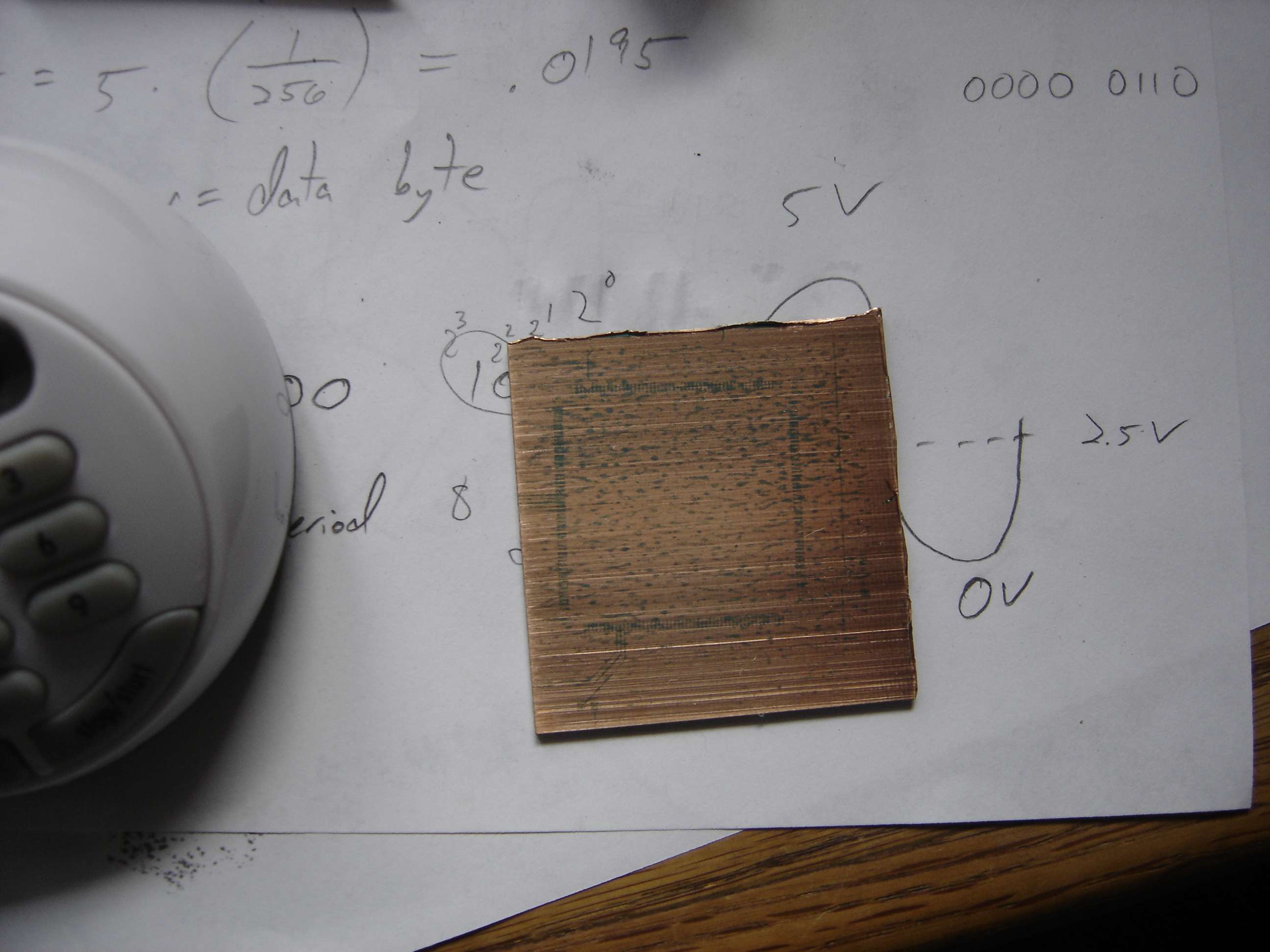
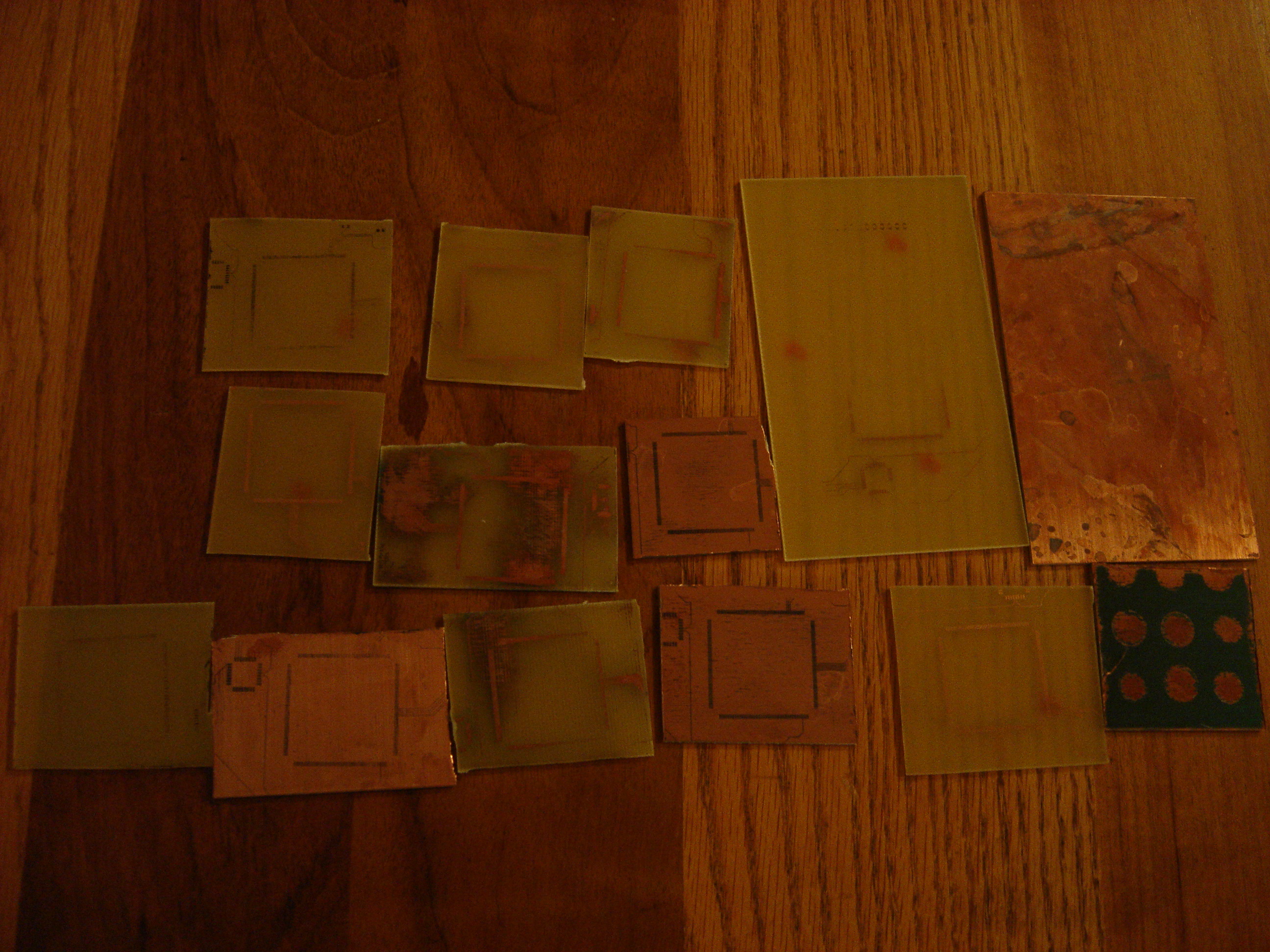
-Having the LEDs too close to the printed circuit board in the light box. The LEDs need to be sufficiently far enough for light to spread evenly throughout the circuit board. 10 inches away from the LEDs worked for us.
-Using textured transparency paper. The UV light did not pass through the transparency because of the texture. The solution is to use non-textured transparency paper. The photoresist will have little streaks of un-exposed UV. The MG Chemical brand transparencies worked well.
-Using sodium carbonate and sodium bicarbonate as a photoresist developer. Neither of these worked for us.
-Too much sodium hydroxide when used as a photoresist developer. All of the photoresist (including the non-exposed UV) was washed away in a few seconds. We suggest measuring the amount of sodium hydroxide and finding a mixture that works. If you don't want to spend the time doing that, use the MG Chemical photoresist developer.
-Adding sodium hydroxide while the PCB is already in the photoresist developer solution. This will instantly remove undesired parts of your photoresist. We suggest stirring the solution first, then dipping the PCB in the solution. If you need to add more sodium hydroxide, take the board out, add sodium hydroxide, stir the solution, then put the board in when the solution is mixed up well.
-Using "party" blacklights. We originally used three 4W party blacklights in an old scanner. The blacklights did work but not as well as the LEDs.
-Using a 500W halogen bulb. This bulb was too intense. It was difficult to find the correct exposure time.
-Using full size PCB's for testing. Don't waste your money using full size PCB's when testing, expecting the first board to work. Use a Dremel or paper cutter to cut a large PCB to save money.
-Using textured transparency paper. The UV light did not pass through the transparency because of the texture. The solution is to use non-textured transparency paper. The photoresist will have little streaks of un-exposed UV. The MG Chemical brand transparencies worked well.
-Using sodium carbonate and sodium bicarbonate as a photoresist developer. Neither of these worked for us.
-Too much sodium hydroxide when used as a photoresist developer. All of the photoresist (including the non-exposed UV) was washed away in a few seconds. We suggest measuring the amount of sodium hydroxide and finding a mixture that works. If you don't want to spend the time doing that, use the MG Chemical photoresist developer.
-Adding sodium hydroxide while the PCB is already in the photoresist developer solution. This will instantly remove undesired parts of your photoresist. We suggest stirring the solution first, then dipping the PCB in the solution. If you need to add more sodium hydroxide, take the board out, add sodium hydroxide, stir the solution, then put the board in when the solution is mixed up well.
-Using "party" blacklights. We originally used three 4W party blacklights in an old scanner. The blacklights did work but not as well as the LEDs.
-Using a 500W halogen bulb. This bulb was too intense. It was difficult to find the correct exposure time.
-Using full size PCB's for testing. Don't waste your money using full size PCB's when testing, expecting the first board to work. Use a Dremel or paper cutter to cut a large PCB to save money.